- Phrases and Clauses
- Parts of a Sentence
- Modal Verbs
- Relative Clauses
- Confusing Words
- Online Grammar Quizzes
- Printable Grammar Worksheets
- Courses to purchase
- Grammar Book
- Grammar Blog

Free English Grammar Worksheets
These free English Grammar Worksheets or practice sheets are an excellent way to improve your grammar.
You can download and print them off as PDFs so they are excellent grammar resources for the classroom if you are a teacher.
All the worksheets can be accessed through the links below and they are all with answers . They are also available as interactive online grammar quizzes .
Printable English Grammar Worksheets (With Answers)
Adverbial clauses.
- Adverbs of Concession and Manner
- Adverbs of Cause and Reasons
- Adverbs of Time
- Adverbs of Condition
Conditional Clauses
- The Zero Conditional
- Type 1 Conditional Clauses
- Type 2 Conditional Clauses
- Type 3 Conditional Clauses
- Mixed Type Conditionals
- Mixed Exercises (Part 1)
- Mixed Exercises (Part 2)
- Intermediate Worksheets 1
- Intermediate Worksheets 2
- Intermediate Worksheets 3
- Intermediate Worksheets 4
- Advanced Worksheets 1
- Advanced Worksheets 2
- Advanced Worksheets 3
- Advanced Worksheets 4
- Defining and Non-defining
Present Simple
- Mixed Forms
- Affirmative
- Interrogative (Yes / No Questions)
- Interrogative (Question Words)
- More exercises
- Worksheets from the Web
Present Perfect Simple
Present perfect continuous, past simple.
- Affirmative (Regular Verbs)
- Affirmative (Irregular Verbs)
Past Continuous
- Uses of the Past Continuous
Past Perfect
- Interrogative (Questions Words)
Past Perfect Continuous
Future simple.
- Affirmative ('will' & 'be going to')
Future Perfect Simple
Future perfect continuous.
- Interrogative
Sentence Structure
- Identifying Phrases and Clauses
- Identifying Clauses
- Identifying the 8 Parts of Speech
- Converting Active to Passive Voice
- Substitution
- Direct and Indirect Objects
- Subject and Object Complements
- Transitive and Intransitive Verbs
- Used to (repeated past actions)
Nouns and Pronouns
- Pronoun Antecedent Agreement
- Sentence Nominalisation Practice
- Relative Pronouns
- Gerund or Present Participle
- Common vs Proper Nouns
- Demonstrative Adjectives (this, that, these, those)
- Quantifiers
- Types of Adjective 1
- Types of Adjective 2
- Possessive Adjectives
- Indefinite Adjectives
- Predicate Adjectives
Direct & Indirect Speech
- Converting Direct to Indirect Speech
Confusing Words
- Affect vs Effect
- Be/Get Used To
- Hanged vs Hung
- Either or Neither
New! Comments
Any questions or comments about the grammar discussed on this page?
Post your comment here.

Sign up for free grammar tips, quizzes and lessons, straight into your inbox
Grammar Rules
Subscribe to grammar wiz:, grammar ebook.

This is an affiliate link
Recent Articles
Future continuous tense quiz: yes/no questions.
Jun 29, 24 11:04 AM
Future Continuous Affirmative Tense Quiz
Future continuous interrogative tense quiz.
Jun 29, 24 11:03 AM
Important Pages
Online Quizzes Grammar Lessons Courses Blog
Connect with Us
Search Site
Privacy Policy / Disclaimer / Terms of Use
Home of English Grammar
English Grammar Exercises
Click on a title to take a multiple-choise exercise online, or use the search form at the top to find a specific topic.
You are also welcome to download and share these English grammar exercises with friends, colleagues, or use them in your classes with students.
To view an exercise, simply click on its title. To download, click on the red PDF icon next to it, and your browser will automatically start the download.

For a better experience, please open this page in your default browser.

Addition (Basic)
Addition (Multi-Digit)
Algebra & Pre-Algebra
Comparing Numbers
Daily Math Review
Division (Basic)
Division (Long Division)
Hundreds Charts
Measurement
Multiplication (Basic)
Multiplication (Multi-Digit)
Order of Operations
Place Value
Probability
Skip Counting
Subtraction
Telling Time
Word Problems (Daily)
More Math Worksheets
Reading Comprehension
Reading Comprehension Gr. 1
Reading Comprehension Gr. 2
Reading Comprehension Gr. 3
Reading Comprehension Gr. 4
Reading Comprehension Gr. 5
Reading Comprehension Gr. 6
Reading & Writing
Reading Worksheets
Cause & Effect
Fact & Opinion
Fix the Sentences
Graphic Organizers
Synonyms & Antonyms
Writing Prompts
Writing Story Pictures
Writing Worksheets
More ELA Worksheets
Consonant Sounds
Vowel Sounds
Consonant Blends
Consonant Digraphs
Word Families
More Phonics Worksheets
Early Literacy
Build Sentences
Sight Word Units
Sight Words (Individual)
More Early Literacy
Punctuation
Subjects and Predicates
More Grammar Worksheets
Spelling Lists
Spelling Grade 1
Spelling Grade 2
Spelling Grade 3
Spelling Grade 4
Spelling Grade 5
Spelling Grade 6
More Spelling Worksheets
Chapter Books
Charlotte's Web
Magic Tree House #1
Boxcar Children
More Literacy Units
Animal (Vertebrate) Groups
Butterfly Life Cycle
Electricity
Matter (Solid, Liquid, Gas)
Simple Machines
Space - Solar System
More Science Worksheets
Social Studies
Maps (Geography)
Maps (Map Skills)
More Social Studies
Mother's Day
Father's Day
More Holiday Worksheets
Puzzles & Brain Teasers
Brain Teasers
Logic: Addition Squares
Mystery Graph Pictures
Number Detective
Lost in the USA
More Thinking Puzzles
Teacher Helpers
Teaching Tools
Award Certificates
More Teacher Helpers
Pre-K and Kindergarten
Alphabet (ABCs)
Numbers and Counting
Shapes (Basic)
More Kindergarten
Worksheet Generator
Word Search Generator
Multiple Choice Generator
Fill-in-the-Blanks Generator
More Generator Tools
Full Website Index
Grammar Worksheets

Adjectives are words that describe nouns and other adjectives.
Adverbs are words that describe action verbs.
This page has links to printables for teaching students about the articles a , an , the .
Use a capital letter at the beginning of a sentence and for proper nouns.
Learn all about cause and effect relationships.
Here's a set of worksheets for teaching students to correctly use commas in their writing.
Learn the differences between pairs of commonly confused words, such as loss/lose, your/you're, lie/lay, and many others.
A compound word is created when two smaller words are combined to make a new word.
Conjunctions are used to join words, phrases, clauses, or sentences together.
A contraction is a pair of words joined by an apostrophe.
Use these printable grammar worksheets to practice diagramming sentences.
This page has advanced-level grammar worksheets for direct objects and transitive verbs.
Use these worksheets to help teach students about avoiding double negatives in writing.
Homographs are words that are spelled the same way, but have different meanings. Sometimes they have different pronunciations too.
Homophones are words that sound alike but have different meanings.
On these worksheets, students practice identifying the correct part of speech for specific words in sentences.
A noun is a person, place, thing, or idea.
Use these worksheets to help students learn about singular and plural possessive nouns.
Worksheets that can help you teach root words along with basic prefixes and suffixes.
Develop your students' understanding of prepositional phrases.
A pronoun is a word that takes the place of a noun.
Build proofreading skills by editing these mistake-filled paragraphs.
These worksheets will help students learn about exclamation points, periods, question marks, quotation marks, and commas.
With these printables, you can help your students learn how to use quotation marks in their written dialogue.
Identify the subject and predicate in each of these sentences.
Divide the words into syllables.
Verbals are verb forms that take on the jobs of other parts of speech. Infinitives, gerunds, and participles are verbals.
Learn about action verbs and linking verbs with these printables.
Learn to differentiate between sentences written in active voice and passive voice.
View the complete index of Language Arts worksheets available on Super Teacher Worksheets.
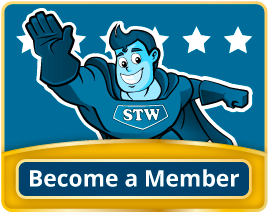
Grammar Exercises
Perfect english grammar.
- Irregular Past Simple, Part 1
- Irregular Past Simple, Part 2
- Irregular Past Participle, Part 1
- Irregular Past Participle, Part 2
- Present Simple Positive with 'be'
- Present Simple Negative with 'be'
- Present Simple Yes / No Questions with 'be'
- Present Simple 'Wh' Questions with 'be'
- Present Simple Mixed Exercise 1 with 'be'
- Present Simple Mixed Exercise 2 with 'be'
- Present Simple Positive 1
- Present Simple Positive 2
- Present Simple Negative 1
- Present Simple Negative 2
- Present Simple Yes / No Questions
- Present Simple 'Wh' Questions
- Present Simple Mixed Forms 1
- Present Simple Mixed Forms 2
- Present Simple Mixed Forms 3
- Present Simple Mixed Forms Be and Other Verbs
- Present Simple Spelling Changes
- Present Continuous Positive and Negative 1
- Present Continuous Positive and Negative 2
- Present Continuous 'Wh' and 'Yes / No' Questions 1
- Present Continuous 'Wh' and 'Yes / No' Questions 2
- Present Continuous Mixed Exercise 1
- Present Continuous Mixed Exercise 2
- Present Continuous Mixed Exercise 3
- Choose the Present Simple or Present Continuous Exercise 1
- Choose the Present Simple or Present Continuous Exercise 2
- Choose the Present Simple or Present Continuous Exercise 3
- Present Perfect Positive
- Present Perfect Negative
- Present Perfect Questions
- Present Perfect All Forms Mixed Exercise 1
- Present Perfect All Forms Mixed Exercise 2
- Choose the Past Simple or Present Perfect Exercise 1
- Choose the Past Simple or Present Perfect Exercise 2
- Choose the Past Simple or Present Perfect Exercise 3
- Choose the Past Simple or Present Perfect Exercise 4
- Present Perfect Continuous Positive and Negative
- Present Perfect Continuous Questions
- Choose the Present Perfect Simple or Continuous 1
- Choose the Present Perfect Simple or Continuous 2
- Choose the Present Perfect Simple or Continuous 3
- Past Simple Positive and Negative with 'be'
- Past Simple Questions with 'be'
- Past Simple All Forms with 'be' Mixed Exercise
- Past Simple Positive Irregular Verbs (exercise 1)
- Past Simple Positive Irregular Verbs (exercise 2)
- Past Simple Negative
- Past Simple 'Yes / No' Questions
- Past Simple 'Wh' Questions
- Past Simple All Forms Mixed Exercise 1
- Past Simple All Forms Mixed Exercise 2
- Past Simple All Forms Mixed Exercise 3
- Past Simple All Forms Mixed Exercise 4
- Past Continuous Positive and Negative
- Past Continuous Questions
- Past Continuous Mixed Exercise 1
- Past Continuous Mixed Exercise 2
- Past Simple or Past Continuous Exercise 1
- Past Simple or Past Continuous Exercise 2
- Past Perfect Simple Positive and Negative
- Past Perfect Simple Questions
- Choose the Past Perfect or the Past Simple
- Past Perfect Continuous Positive
- Past Perfect Continuous Negative
- Past Perfect Continuous Questions
- Past Perfect Simple or Past Perfect Continuous
- Past Perfect Continuous or Past Simple Exercise 1
- Future Simple Positive
- Future Simple Negative
- Future Simple Questions
- Future Simple or Present Simple Exercise 1
- Future Continuous Positive
- Future Continuous Negative
- Future Continuous Questions
- Future Perfect Positive
- Future Perfect Negative
- Future Perfect Questions
- Mixed Future Perfect Exercise
- Future Perfect Continuous Positive
- Future Perfect Continuous Negative
- Future Perfect Continuous Questions
- Mixed Future Perfect Continuous Exercise
- Mixed Future Forms Exercise
- Make the first conditional
- Make the second conditional
- Make the third conditional
- Make the zero conditional
- Make the first, second and third conditionals
- Write your own endings to conditional sentences (PDF)
- Mixed Tense Reported Statements
- Present Simple Reported Statements
- Present Continuous Reported Statements
- Past Simple Reported Statements
- Present Perfect Reported Statements
- Future Simple Reported Statements
- Reported Yes/No Questions
- Reported Wh Questions
- Mixed Reported Questions (PDF)
- Reported Requests and Orders
- Reported Speech Mixed Exercise 1
- Reported Speech Mixed Exercise 2
- 'Say' and 'Tell'
- Passive with the Present Simple
- Passive with the Past Simple
- Passive with the Present Perfect
- Passive with the Future Simple
- Passive with mixed tenses
- Passive with verbs with two objects
- Passive in subordinate clauses
- Defining Relative Clauses 1
- Defining Relative Clauses 2
- Defining Relative Clauses 3
- Defining Relative Clauses 4
- Modal Verbs of Ability 1
- Modal Verbs of Obligation 1
- Modal verbs of Probability 1
- Modal verbs of Probability 2
- Causatives Exercise 1 (Have / Get Something Done)
- Causatives Exercise 2 (Have Someone Do Something / Get Someone to Do Something)
- Ergative and Unaccusative Verbs
- Embedded Questions in Statements
- Indirect Questions 1
- Indirect Questions 2
- Indirect Questions 3
- Time Prepositions 1
- Time Prepositions 2
- Place Prepositions 1
- Place Prepositions 2
- Verbs + Prepositions 1
- Verbs + Prepositions 2
- Adjectives + Prepositions 1
- Participle Adjectives (ED and ING Adjectives) 1
- Participle Adjectives (ED and ING Adjectives) 2
- Adverbs or Adjectives 1
- Comparative Adjectives 1
- Gerunds and Infinitives Exercise 1
- Gerunds and Infinitives Exercise 2
- Gerunds and Infinitives Exercise 3
- Gerunds and Infinitives Exercise 4
- Let and Make Exercise 1
- Make or Do Exercise 1
- Make or Do Exercise 2
- Make or Do Exercise 3
- Make or Do Exercise 4
- Used To Exercise 1
- Used To Exercise 2 ('used to' or 'would')
- Used To Exercise 3 (be used to verb+ing)
- Phrasal Verbs Exercise 1
- Phrasal Verbs Exercise 2
- Phrasal Verbs Exercise 3
- A Little / A Few Exercise 1
- Bed / Home / Work / Town Exercise 1
- Superlatives with The and No Article Exercise 1
- Some and Any Exercise 1
- Some and Any Exercise 2
- Articles with Geographical Names Exercise 1
- Articles with Geographical Names Exercise 2
- As and Like Exercise 1
- Linking Words of Contrast (However / Despite / Although)
- Linking Words of Reason (Because / Since / As / Due to / Owing to)

Hello! I'm Seonaid! I'm here to help you understand grammar and speak correct, fluent English.
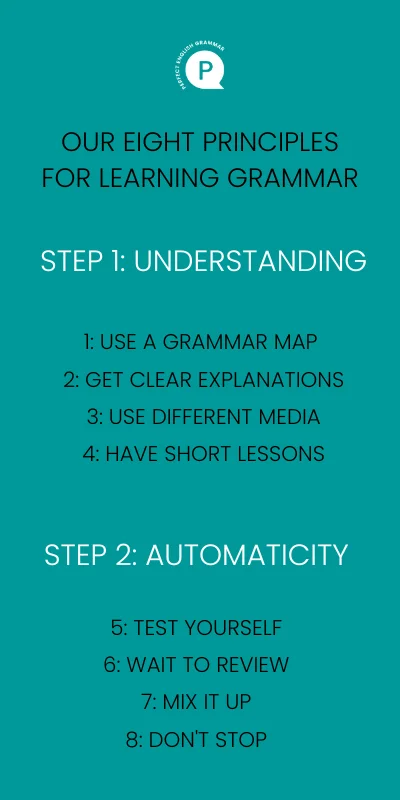
Read more about our learning method
Filter Results
- clear all filters
Resource Type
- Worksheets
- Guided Lessons
- Lesson Plans
- Hands-on Activities
- Interactive Stories
- Online Exercises
- Printable Workbooks
- Science Projects
- Song Videos
middle-school
- Fine arts
- Foreign language
- Math
- Reading
- Writing
- Phonics
- Spelling
- Language and Vocabulary
- Grammar and Mechanics
- Science
- Social emotional
- Social studies
- Typing
- Arts & crafts
- Coloring
- Holidays
- Offline games
- Pop Culture & Events
- Seasonal
- Teacher Resources
- Common Core
Grammar Worksheets and Printables
Key grammar concepts :.

Free tools to make your students better writers and readers .
Quill.org, a non-profit, provides free literacy activities that build reading comprehension, writing, and language skills for elementary, middle, and high school students.
Writing Across the Curriculum: Quill's nonprofit mission is to now build both reading and writing skills through free, OER content across the curriculum. Over the coming years, we will be building a library of free ELA, social studies, and science activities that engage students in deeper thinking through writing prompts that provide immediate feedback.
9 million students have written 2 billion sentences on Quill.
Quill Reading for Evidence
Provide your students with nonfiction texts paired with AI-powered writing prompts, instead of multiple-choice questions, to enable deeper thinking.
Students read a nonfiction text and build their comprehension through writing prompts, supporting a series of claims with evidence sourced from the text. Quill challenges students to write responses that are precise, logical, and based on textual evidence, with Quill coaching the student through custom, targeted feedback on each revision so that students strengthen their reading comprehension and hone their writing skills.
Video not supported
Culture & Society Topics

"Should Schools Have Grade Requirements for Student Athletes?"
Science Topics

"How Does Eating Meat Impact Global Warming?"
Social Studies Topics

U.S. History
World History
Under Development, Coming 2023
Quill Connect
Help your students advance from fragmented and run-on sentences to complex and well structured ones.
Using the evidence-based strategy of sentence combining, students combine multiple ideas into a single sentence. They then receive instant feedback designed to help them improve their clarity and precision.
Quill Lessons
The Quill Lessons tool enables teachers to lead whole-class and small-group writing instruction.
Teachers control interactive slides that contain writing prompts, and the entire class responds to each prompt. Each Quill Lessons activity provides a lesson plan, writing prompts, discussion topics, and a follow up independent practice activity.
Quill Diagnostic
Quickly determine which skills your students need to work on with our diagnostics.
The diagnostics cover vital sentence construction skills and generate personalized learning plans based on the student’s performance.

Quill Proofreader
Proofreader teaches your students editing skills by having them proofread passages.
Students edit passages and receive personalized exercises based on their results. With over 100 expository passages, Proofreader gives students the practice they need to spot common grammatical errors.
Quill Grammar
Students practice basic grammar skills, from comma placement to parallel structure.
Quill Grammar has over 150 sentence writing activities to help your students. Our activities are designed to be completed in 10 minutes so you have the freedom to use them in the way that works best for your classroom.
How Quill Works
Set up your classroom, without it.
You can quickly and easily set up your classroom in Quill by inputting student names or providing students with a unique code. If you use Google Classroom or Clever, you can automatically set up your classroom with one click.
Choose activities
Decide if you want your students to proofread passages, combine sentences, or complete a diagnostic. Use our ten minute activities as building blocks during your classroom instruction.
Use easy-to-consume reporting
Use our reporting to spot trends and identify growth opportunities. Monitor comprehension on specific writing standards.
Get immediate feedback for your students
Save time grading and watch your students correct their mistakes instantly.
Intervene where students struggle
See exactly where your students need intervention with our comprehensive reports.
Differentiate learning to meet the needs of all students
Assign specific activities for ELLs and students with learning differences.
Engage students with adaptive activities
Challenge students with questions that automatically adapt based on their previous responses.
Align with the Common Core Standards
Easily meet Common Core language standards with our aligned activities.
Easily sign up with Google Classroom
With one click all of your students and classes will be imported.
Over 100 concepts totaling 50 hours of quality curriculum.
Teacher stories
Quill in the classroom.
ROXANNA BUTKUS, RANGEVIEW ELEMENTARY
SARA ANGEL, KIPP LA
COLETTE KANG, EAST BAY INNOVATION ACADEMY
DANIEL SCIBIENSKI, PRINCETON PUBLIC SCHOOLS
3rd Grade ELA
5th Grade ELA
6th Grade ELA
8th Grade ELA & ELL
Join over 2,000 schools using Quill to advance student writing.

Quill Premium
Quill Premium's advanced reporting features are the best way to support teachers at the school or district level.

Reading Worksheets, Spelling, Grammar, Comprehension, Lesson Plans
Grammar Worksheets
Grammar is a fundamental concept that helps students to gain valuable skills in reading comprehension and writing. We've developed hundreds of grammar worksheets around topics like parts of speech, mechanics, parts of sentences, word usage, punctuation, and sentence structure. You'll find practice activities for kindergarten through high school and everywhere in between! All of our worksheets address specific aspects of common core and teach concepts that help your students learn. Feel free to print for use at home or in the classroom.
Grammar Mechanics Worksheets
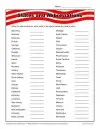
Parts of Speech Worksheets
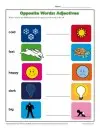
This section includes free, printable worksheets about parts of speech: Nouns, Pronouns, Verbs, Adjectives and Articles, Adverbs, Conjunctions, Interjections, Prepositions.
Parts of a Sentence Worksheets
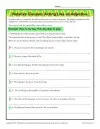
This section includes worksheets about Parts of Sentences: Subject, Predicate, Direct Objects, Indirect Objects, Clauses, Prepositional Phrases, and more.
Punctuation Worksheets
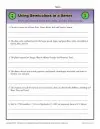
Sentence Structure Worksheets

Word Usage Worksheets
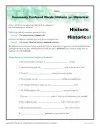

- Walden University
- Faculty Portal
Grammar: Sentence Structure and Types of Sentences
Definitions and examples of basic sentence elements.
The Mastering the Mechanics webinar series also describes required sentence elements and varying sentence types. Please see these archived webinars for more information.
Key: Yellow, bold = subject; green underline = verb, blue, italics = object, pink, regular font = prepositional phrase
Independent clause : An independent clause can stand alone as a sentence. It contains a subject and a verb and is a complete idea.
- I like spaghetti .
- He reads many books .
Dependent clause : A dependent clause is not a complete sentence. It must be attached to an independent clause to become complete. This is also known as a subordinate clause.
- Although I like spaghetti,…
- Because he reads many books,…
Subject : A person, animal, place, thing, or concept that does an action. Determine the subject in a sentence by asking the question “Who or what?”
- I like spaghetti.
- He reads many books.
Verb : Expresses what the person, animal, place, thing, or concept does. Determine the verb in a sentence by asking the question “What was the action or what happened?”
- The movie is good. (The be verb is also sometimes referred to as a copula or a linking verb. It links the subject, in this case "the movie," to the complement or the predicate of the sentence, in this case, "good.")
Object : A person, animal, place, thing, or concept that receives the action. Determine the object in a sentence by asking the question “The subject did what?” or “To whom?/For whom?”
Prepositional Phrase : A phrase that begins with a preposition (i.e., in, at for, behind, until, after, of, during) and modifies a word in the sentence. A prepositional phrase answers one of many questions. Here are a few examples: “Where? When? In what way?”
- I like spaghetti for dinner .
- He reads many books in the library .
English Sentence Structure
The following statements are true about sentences in English:
- H e obtained his degree.
- He obtained his degree .
- Smith he obtained his degree.
- He obtained his degree.
- He (subject) obtained (verb) his degree (object).
Simple Sentences
A simple sentence contains a subject and a verb, and it may also have an object and modifiers. However, it contains only one independent clause.
Key: Yellow, bold = subject; green underline = verb, blue, italics = object, pink, regular font =prepositional phrase
Here are a few examples:
- She wrote .
- She completed her literature review .
- He organized his sources by theme .
- They studied APA rules for many hours .
Compound Sentences
A compound sentence contains at least two independent clauses. These two independent clauses can be combined with a comma and a coordinating conjunction or with a semicolon .
Key: independent clause = yellow, bold ; comma or semicolon = pink, regular font ; coordinating conjunction = green, underlined
- She completed her literature review , and she created her reference list .
- He organized his sources by theme ; then, he updated his reference list .
- They studied APA rules for many hours , but they realized there was still much to learn .
Using some compound sentences in writing allows for more sentence variety .
Complex Sentences
A complex sentence contains at least one independent clause and at least one dependent clause. Dependent clauses can refer to the subject (who, which) the sequence/time (since, while), or the causal elements (because, if) of the independent clause.
If a sentence begins with a dependent clause, note the comma after this clause. If, on the other hand, the sentence begins with an independent clause, there is not a comma separating the two clauses.
Key: independent clause = yellow, bold ; comma = pink, regular font ; dependent clause = blue, italics
- Note the comma in this sentence because it begins with a dependent clause.
- Note that there is no comma in this sentence because it begins with an independent clause.
- Using some complex sentences in writing allows for more sentence variety .
Compound-Complex Sentences
Sentence types can also be combined. A compound-complex sentence contains at least two independent clauses and at least one dependent clause.
Key: independent clause = yellow, bold ; comma or semicolon = pink, regular font ; coordinating conjunction = green, underlined ; dependent clause = blue, italics
- She completed her literature review , but she still needs to work on her methods section even though she finished her methods course last semester .
- Although he organized his sources by theme , he decided to arrange them chronologically , and he carefully followed the MEAL plan for organization .
- T hey studied APA rules for many hours , and they decided that writing in APA made sense because it was clear, concise, and objective .
- Using some complex-compound sentences in writing allows for more sentence variety .
- Pay close attention to comma usage in complex-compound sentences so that the reader is easily able to follow the intended meaning.
Sentence Structure Video Playlist
Note that these videos were created while APA 6 was the style guide edition in use. There may be some examples of writing that have not been updated to APA 7 guidelines.
- Structuring Sentences: Types of Sentences (video transcript)
- Structuring Sentences: Simple Sentences (video transcript)
- Structuring Sentences: Compound Sentences (video transcript)
- Structuring Sentences: Complex Sentences (video transcript)
- Structuring Sentences: Combining Sentences (video transcript)
- Common Error: Unclear Subjects (video transcript)
- Mastering the Mechanics: Punctuation as Symbols (video transcript)
- Mastering the Mechanics: Commas (video transcript)
- Mastering the Mechanics: Periods (video transcript)
- Mastering the Mechanics: Semicolons (video transcript)
Related Resources
Knowledge Check: Sentence Structure and Types of Sentences
Didn't find what you need? Email us at [email protected] .
- Previous Page: Main Parts of Speech
- Next Page: Run-On Sentences and Sentence Fragments
- Office of Student Disability Services

Walden Resources
Departments.
- Academic Residencies
- Academic Skills
- Career Planning and Development
- Customer Care Team
- Field Experience
- Military Services
- Student Success Advising
- Writing Skills
Centers and Offices
- Center for Social Change
- Office of Academic Support and Instructional Services
- Office of Degree Acceleration
- Office of Research and Doctoral Services
- Office of Student Affairs
Student Resources
- Doctoral Writing Assessment
- Form & Style Review
- Quick Answers
- ScholarWorks
- SKIL Courses and Workshops
- Walden Bookstore
- Walden Catalog & Student Handbook
- Student Safety/Title IX
- Legal & Consumer Information
- Website Terms and Conditions
- Cookie Policy
- Accessibility
- Accreditation
- State Authorization
- Net Price Calculator
- Contact Walden
Walden University is a member of Adtalem Global Education, Inc. www.adtalem.com Walden University is certified to operate by SCHEV © 2024 Walden University LLC. All rights reserved.
EnglishForEveryone.org
Paragraph correction worksheets terms of use, beginning level paragraph correction worksheets.
- Answer Key - This is the answer key to beginning level worksheets.
- Beginning Paragraph Correction Worksheet 1
- Beginning Paragraph Correction Worksheet 2
- Beginning Paragraph Correction Worksheet 3
- Beginning Paragraph Correction Worksheet 4
- Beginning Paragraph Correction Worksheet 5
- Beginning Paragraph Correction Worksheet 6
- Beginning Paragraph Correction Worksheet 7
- Beginning Paragraph Correction Worksheet 8
- Beginning Paragraph Correction Worksheet 9
- Beginning Paragraph Correction Worksheet 10
- Beginning Paragraph Correction Worksheet 11
- Beginning Paragraph Correction Worksheet 12
- Beginning Paragraph Correction Worksheet 13
- Beginning Paragraph Correction Worksheet 14
- Beginning Paragraph Correction Worksheet 15
Intermediate Level Paragraph Correction Worksheets
- Answer Key - This is the answer key to intermediate level worksheets.
- Intermediate Paragraph Correction Worksheet 1
- Intermediate Paragraph Correction Worksheet 2
- Intermediate Paragraph Correction Worksheet 3
- Intermediate Paragraph Correction Worksheet 4
- Intermediate Paragraph Correction Worksheet 5
- Intermediate Paragraph Correction Worksheet 6
- Intermediate Paragraph Correction Worksheet 7
- Intermediate Paragraph Correction Worksheet 8
- Intermediate Paragraph Correction Worksheet 9
- Intermediate Paragraph Correction Worksheet 10
- Intermediate Paragraph Correction Worksheet 11
- Intermediate Paragraph Correction Worksheet 12
- Intermediate Paragraph Correction Worksheet 13
- Intermediate Paragraph Correction Worksheet 14
- Intermediate Paragraph Correction Worksheet 15
Advanced Level Paragraph Correction Worksheets
- Answer Key - This is the answer key to advanced level worksheets.
- Advanced Paragraph Correction Worksheet 1
- Advanced Paragraph Correction Worksheet 2
- Advanced Paragraph Correction Worksheet 3
- Advanced Paragraph Correction Worksheet 4
- Advanced Paragraph Correction Worksheet 5
- Advanced Paragraph Correction Worksheet 6
- Advanced Paragraph Correction Worksheet 7
- Advanced Paragraph Correction Worksheet 8
- Advanced Paragraph Correction Worksheet 9
- Advanced Paragraph Correction Worksheet 10
Home | About | Privacy Policy | Terms of Use | Contact Us

| Dictionary | |
Grammar exercises
Vocabulary exercises
Verbs exercises
Listening exercises
Reading - exercises
Videos - lessons
Songs - nursery-rhymes
Stories - fairy-tales
Phonetic - exercises
Worksheets - handouts
Grammar - 1
Exercises: all levels esl.
- Alphabet - spelling
- Articles: a / an / the
- Any / some - indefinite
- Adjectives - exercises
- Comparatives / comparison
- Many / much - exercises
- Few / little - exercises
- Plural - exercises
- Possessives - exercises
- Prepositions : place
- Prepositions : time
- Prepositions - mixed
- Pronouns: personal / object
- Pronouns - mixed
- Questions - exercises
- Question tags
- There is / there are
- This-that / these-those

Understanding Assignments
What this handout is about.
The first step in any successful college writing venture is reading the assignment. While this sounds like a simple task, it can be a tough one. This handout will help you unravel your assignment and begin to craft an effective response. Much of the following advice will involve translating typical assignment terms and practices into meaningful clues to the type of writing your instructor expects. See our short video for more tips.
Basic beginnings
Regardless of the assignment, department, or instructor, adopting these two habits will serve you well :
- Read the assignment carefully as soon as you receive it. Do not put this task off—reading the assignment at the beginning will save you time, stress, and problems later. An assignment can look pretty straightforward at first, particularly if the instructor has provided lots of information. That does not mean it will not take time and effort to complete; you may even have to learn a new skill to complete the assignment.
- Ask the instructor about anything you do not understand. Do not hesitate to approach your instructor. Instructors would prefer to set you straight before you hand the paper in. That’s also when you will find their feedback most useful.
Assignment formats
Many assignments follow a basic format. Assignments often begin with an overview of the topic, include a central verb or verbs that describe the task, and offer some additional suggestions, questions, or prompts to get you started.
An Overview of Some Kind
The instructor might set the stage with some general discussion of the subject of the assignment, introduce the topic, or remind you of something pertinent that you have discussed in class. For example:
“Throughout history, gerbils have played a key role in politics,” or “In the last few weeks of class, we have focused on the evening wear of the housefly …”
The Task of the Assignment
Pay attention; this part tells you what to do when you write the paper. Look for the key verb or verbs in the sentence. Words like analyze, summarize, or compare direct you to think about your topic in a certain way. Also pay attention to words such as how, what, when, where, and why; these words guide your attention toward specific information. (See the section in this handout titled “Key Terms” for more information.)
“Analyze the effect that gerbils had on the Russian Revolution”, or “Suggest an interpretation of housefly undergarments that differs from Darwin’s.”
Additional Material to Think about
Here you will find some questions to use as springboards as you begin to think about the topic. Instructors usually include these questions as suggestions rather than requirements. Do not feel compelled to answer every question unless the instructor asks you to do so. Pay attention to the order of the questions. Sometimes they suggest the thinking process your instructor imagines you will need to follow to begin thinking about the topic.
“You may wish to consider the differing views held by Communist gerbils vs. Monarchist gerbils, or Can there be such a thing as ‘the housefly garment industry’ or is it just a home-based craft?”
These are the instructor’s comments about writing expectations:
“Be concise”, “Write effectively”, or “Argue furiously.”
Technical Details
These instructions usually indicate format rules or guidelines.
“Your paper must be typed in Palatino font on gray paper and must not exceed 600 pages. It is due on the anniversary of Mao Tse-tung’s death.”
The assignment’s parts may not appear in exactly this order, and each part may be very long or really short. Nonetheless, being aware of this standard pattern can help you understand what your instructor wants you to do.
Interpreting the assignment
Ask yourself a few basic questions as you read and jot down the answers on the assignment sheet:
Why did your instructor ask you to do this particular task?
Who is your audience.
- What kind of evidence do you need to support your ideas?
What kind of writing style is acceptable?
- What are the absolute rules of the paper?
Try to look at the question from the point of view of the instructor. Recognize that your instructor has a reason for giving you this assignment and for giving it to you at a particular point in the semester. In every assignment, the instructor has a challenge for you. This challenge could be anything from demonstrating an ability to think clearly to demonstrating an ability to use the library. See the assignment not as a vague suggestion of what to do but as an opportunity to show that you can handle the course material as directed. Paper assignments give you more than a topic to discuss—they ask you to do something with the topic. Keep reminding yourself of that. Be careful to avoid the other extreme as well: do not read more into the assignment than what is there.
Of course, your instructor has given you an assignment so that they will be able to assess your understanding of the course material and give you an appropriate grade. But there is more to it than that. Your instructor has tried to design a learning experience of some kind. Your instructor wants you to think about something in a particular way for a particular reason. If you read the course description at the beginning of your syllabus, review the assigned readings, and consider the assignment itself, you may begin to see the plan, purpose, or approach to the subject matter that your instructor has created for you. If you still aren’t sure of the assignment’s goals, try asking the instructor. For help with this, see our handout on getting feedback .
Given your instructor’s efforts, it helps to answer the question: What is my purpose in completing this assignment? Is it to gather research from a variety of outside sources and present a coherent picture? Is it to take material I have been learning in class and apply it to a new situation? Is it to prove a point one way or another? Key words from the assignment can help you figure this out. Look for key terms in the form of active verbs that tell you what to do.
Key Terms: Finding Those Active Verbs
Here are some common key words and definitions to help you think about assignment terms:
Information words Ask you to demonstrate what you know about the subject, such as who, what, when, where, how, and why.
- define —give the subject’s meaning (according to someone or something). Sometimes you have to give more than one view on the subject’s meaning
- describe —provide details about the subject by answering question words (such as who, what, when, where, how, and why); you might also give details related to the five senses (what you see, hear, feel, taste, and smell)
- explain —give reasons why or examples of how something happened
- illustrate —give descriptive examples of the subject and show how each is connected with the subject
- summarize —briefly list the important ideas you learned about the subject
- trace —outline how something has changed or developed from an earlier time to its current form
- research —gather material from outside sources about the subject, often with the implication or requirement that you will analyze what you have found
Relation words Ask you to demonstrate how things are connected.
- compare —show how two or more things are similar (and, sometimes, different)
- contrast —show how two or more things are dissimilar
- apply—use details that you’ve been given to demonstrate how an idea, theory, or concept works in a particular situation
- cause —show how one event or series of events made something else happen
- relate —show or describe the connections between things
Interpretation words Ask you to defend ideas of your own about the subject. Do not see these words as requesting opinion alone (unless the assignment specifically says so), but as requiring opinion that is supported by concrete evidence. Remember examples, principles, definitions, or concepts from class or research and use them in your interpretation.
- assess —summarize your opinion of the subject and measure it against something
- prove, justify —give reasons or examples to demonstrate how or why something is the truth
- evaluate, respond —state your opinion of the subject as good, bad, or some combination of the two, with examples and reasons
- support —give reasons or evidence for something you believe (be sure to state clearly what it is that you believe)
- synthesize —put two or more things together that have not been put together in class or in your readings before; do not just summarize one and then the other and say that they are similar or different—you must provide a reason for putting them together that runs all the way through the paper
- analyze —determine how individual parts create or relate to the whole, figure out how something works, what it might mean, or why it is important
- argue —take a side and defend it with evidence against the other side
More Clues to Your Purpose As you read the assignment, think about what the teacher does in class:
- What kinds of textbooks or coursepack did your instructor choose for the course—ones that provide background information, explain theories or perspectives, or argue a point of view?
- In lecture, does your instructor ask your opinion, try to prove their point of view, or use keywords that show up again in the assignment?
- What kinds of assignments are typical in this discipline? Social science classes often expect more research. Humanities classes thrive on interpretation and analysis.
- How do the assignments, readings, and lectures work together in the course? Instructors spend time designing courses, sometimes even arguing with their peers about the most effective course materials. Figuring out the overall design to the course will help you understand what each assignment is meant to achieve.
Now, what about your reader? Most undergraduates think of their audience as the instructor. True, your instructor is a good person to keep in mind as you write. But for the purposes of a good paper, think of your audience as someone like your roommate: smart enough to understand a clear, logical argument, but not someone who already knows exactly what is going on in your particular paper. Remember, even if the instructor knows everything there is to know about your paper topic, they still have to read your paper and assess your understanding. In other words, teach the material to your reader.
Aiming a paper at your audience happens in two ways: you make decisions about the tone and the level of information you want to convey.
- Tone means the “voice” of your paper. Should you be chatty, formal, or objective? Usually you will find some happy medium—you do not want to alienate your reader by sounding condescending or superior, but you do not want to, um, like, totally wig on the man, you know? Eschew ostentatious erudition: some students think the way to sound academic is to use big words. Be careful—you can sound ridiculous, especially if you use the wrong big words.
- The level of information you use depends on who you think your audience is. If you imagine your audience as your instructor and they already know everything you have to say, you may find yourself leaving out key information that can cause your argument to be unconvincing and illogical. But you do not have to explain every single word or issue. If you are telling your roommate what happened on your favorite science fiction TV show last night, you do not say, “First a dark-haired white man of average height, wearing a suit and carrying a flashlight, walked into the room. Then a purple alien with fifteen arms and at least three eyes turned around. Then the man smiled slightly. In the background, you could hear a clock ticking. The room was fairly dark and had at least two windows that I saw.” You also do not say, “This guy found some aliens. The end.” Find some balance of useful details that support your main point.
You’ll find a much more detailed discussion of these concepts in our handout on audience .
The Grim Truth
With a few exceptions (including some lab and ethnography reports), you are probably being asked to make an argument. You must convince your audience. It is easy to forget this aim when you are researching and writing; as you become involved in your subject matter, you may become enmeshed in the details and focus on learning or simply telling the information you have found. You need to do more than just repeat what you have read. Your writing should have a point, and you should be able to say it in a sentence. Sometimes instructors call this sentence a “thesis” or a “claim.”
So, if your instructor tells you to write about some aspect of oral hygiene, you do not want to just list: “First, you brush your teeth with a soft brush and some peanut butter. Then, you floss with unwaxed, bologna-flavored string. Finally, gargle with bourbon.” Instead, you could say, “Of all the oral cleaning methods, sandblasting removes the most plaque. Therefore it should be recommended by the American Dental Association.” Or, “From an aesthetic perspective, moldy teeth can be quite charming. However, their joys are short-lived.”
Convincing the reader of your argument is the goal of academic writing. It doesn’t have to say “argument” anywhere in the assignment for you to need one. Look at the assignment and think about what kind of argument you could make about it instead of just seeing it as a checklist of information you have to present. For help with understanding the role of argument in academic writing, see our handout on argument .
What kind of evidence do you need?
There are many kinds of evidence, and what type of evidence will work for your assignment can depend on several factors–the discipline, the parameters of the assignment, and your instructor’s preference. Should you use statistics? Historical examples? Do you need to conduct your own experiment? Can you rely on personal experience? See our handout on evidence for suggestions on how to use evidence appropriately.
Make sure you are clear about this part of the assignment, because your use of evidence will be crucial in writing a successful paper. You are not just learning how to argue; you are learning how to argue with specific types of materials and ideas. Ask your instructor what counts as acceptable evidence. You can also ask a librarian for help. No matter what kind of evidence you use, be sure to cite it correctly—see the UNC Libraries citation tutorial .
You cannot always tell from the assignment just what sort of writing style your instructor expects. The instructor may be really laid back in class but still expect you to sound formal in writing. Or the instructor may be fairly formal in class and ask you to write a reflection paper where you need to use “I” and speak from your own experience.
Try to avoid false associations of a particular field with a style (“art historians like wacky creativity,” or “political scientists are boring and just give facts”) and look instead to the types of readings you have been given in class. No one expects you to write like Plato—just use the readings as a guide for what is standard or preferable to your instructor. When in doubt, ask your instructor about the level of formality they expect.
No matter what field you are writing for or what facts you are including, if you do not write so that your reader can understand your main idea, you have wasted your time. So make clarity your main goal. For specific help with style, see our handout on style .
Technical details about the assignment
The technical information you are given in an assignment always seems like the easy part. This section can actually give you lots of little hints about approaching the task. Find out if elements such as page length and citation format (see the UNC Libraries citation tutorial ) are negotiable. Some professors do not have strong preferences as long as you are consistent and fully answer the assignment. Some professors are very specific and will deduct big points for deviations.
Usually, the page length tells you something important: The instructor thinks the size of the paper is appropriate to the assignment’s parameters. In plain English, your instructor is telling you how many pages it should take for you to answer the question as fully as you are expected to. So if an assignment is two pages long, you cannot pad your paper with examples or reword your main idea several times. Hit your one point early, defend it with the clearest example, and finish quickly. If an assignment is ten pages long, you can be more complex in your main points and examples—and if you can only produce five pages for that assignment, you need to see someone for help—as soon as possible.
Tricks that don’t work
Your instructors are not fooled when you:
- spend more time on the cover page than the essay —graphics, cool binders, and cute titles are no replacement for a well-written paper.
- use huge fonts, wide margins, or extra spacing to pad the page length —these tricks are immediately obvious to the eye. Most instructors use the same word processor you do. They know what’s possible. Such tactics are especially damning when the instructor has a stack of 60 papers to grade and yours is the only one that low-flying airplane pilots could read.
- use a paper from another class that covered “sort of similar” material . Again, the instructor has a particular task for you to fulfill in the assignment that usually relates to course material and lectures. Your other paper may not cover this material, and turning in the same paper for more than one course may constitute an Honor Code violation . Ask the instructor—it can’t hurt.
- get all wacky and “creative” before you answer the question . Showing that you are able to think beyond the boundaries of a simple assignment can be good, but you must do what the assignment calls for first. Again, check with your instructor. A humorous tone can be refreshing for someone grading a stack of papers, but it will not get you a good grade if you have not fulfilled the task.
Critical reading of assignments leads to skills in other types of reading and writing. If you get good at figuring out what the real goals of assignments are, you are going to be better at understanding the goals of all of your classes and fields of study.
You may reproduce it for non-commercial use if you use the entire handout and attribute the source: The Writing Center, University of North Carolina at Chapel Hill
Make a Gift
Free Grammar Checker
Grammar Checker in partnership with QuillBot. Avoid mistakes everywhere with the free Chrome Extension .
Try our other writing services

Correct your document within 5 minutes
- Proofread on 100+ language issues
- Specialized in academic texts
- Corrections directly in your document
Instantly correct your entire document in minutes
Why this is the best free grammar checker.
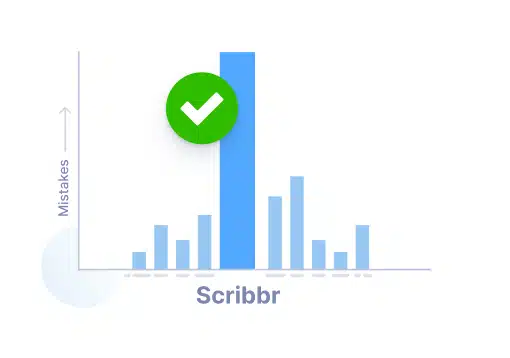
Most accurate
In the test for the best grammar checker , Scribbr found 19 out of 20 errors.

No signup needed
You don’t have to register or sign up. Insert your text and get started right away.
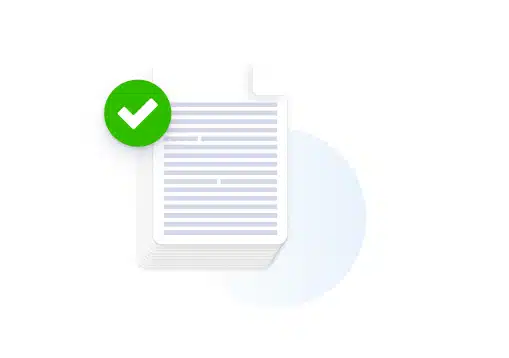
Long texts, short texts it doesn’t matter – there’s no character or word limit.

Don’t wait for ads or distractions. The grammar checker is ad-free!

Correct all your writing errors
Enhance your writing with Scribbr’s free Grammar Checker. We can help you to avoid mistakes with:
- Punctuation
- Word choice
- And more— try it yourself !
We are also happy to provide personalized help with our professional proofreading service .
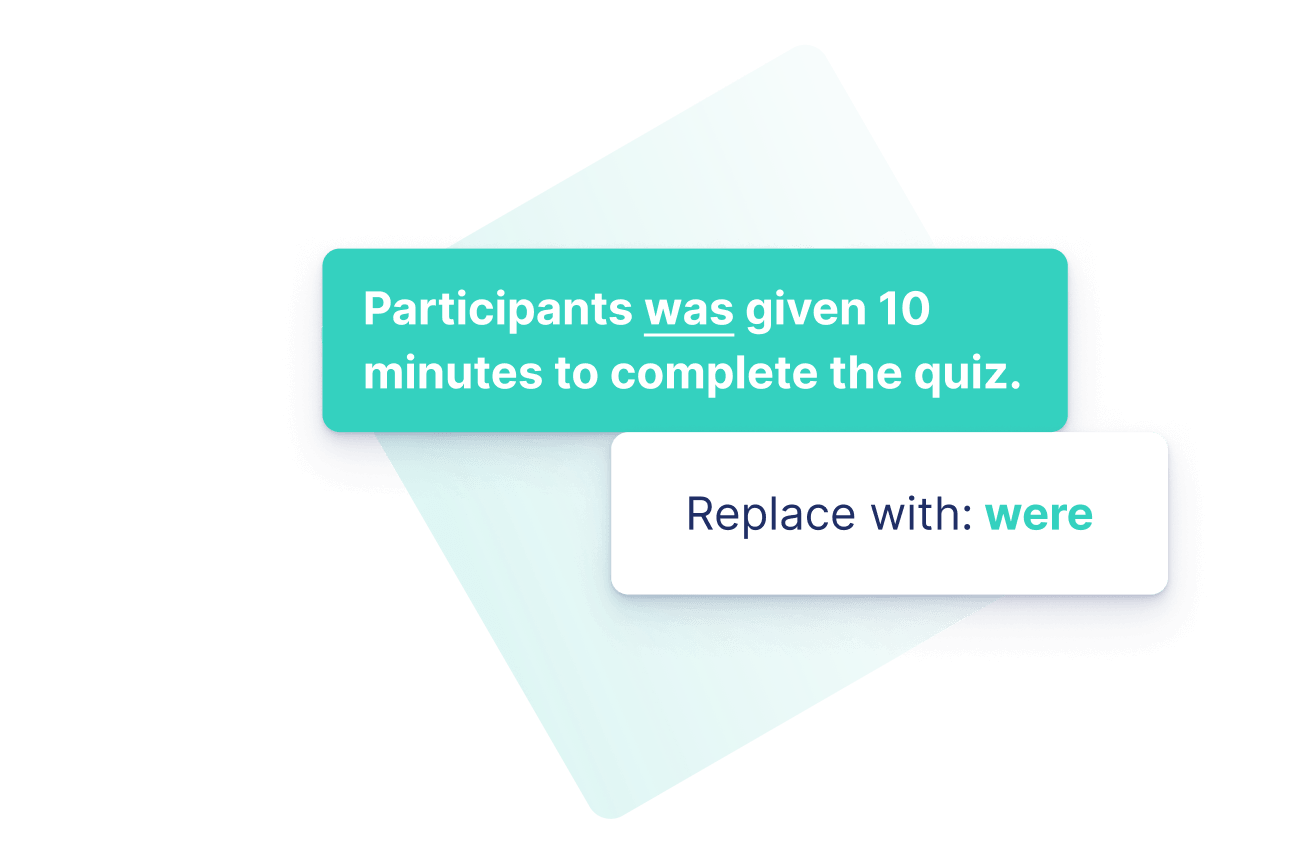
Correct your grammar
Improve your writing and grammar with just one click.
The Scribbr Grammar Checker fixes grammatical errors like:
- Sentence fragments & run-on sentences
- Subject-verb agreement errors
- Issues with parallelism
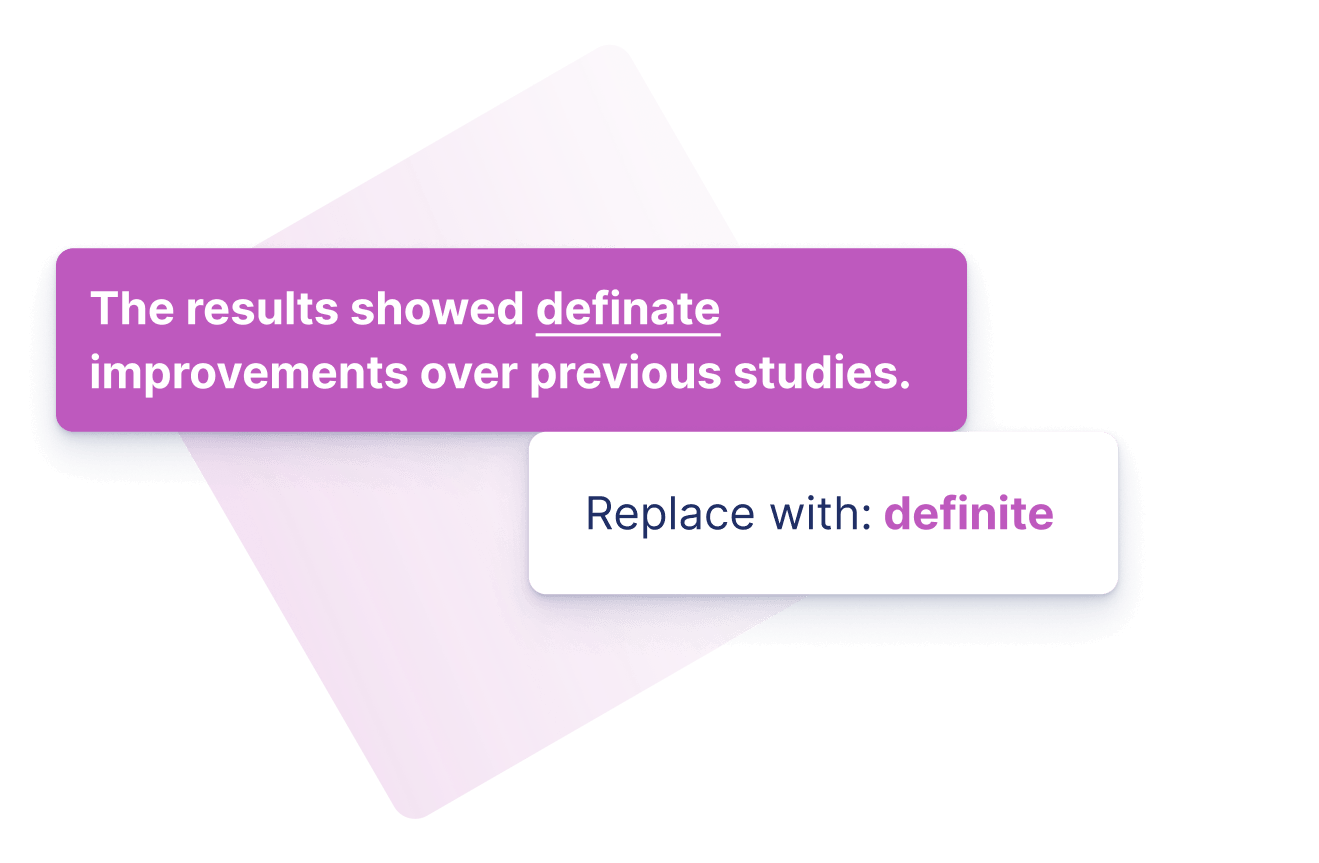
Spell-check on steroids
Spelling may seem straightforward, but basic spell-checks often don’t recognize many specialist terms you might use in your writing, incorrectly marking them as mistakes.
Scribbr has a large dictionary of recognized words, so you can feel confident every word is 100% correct.
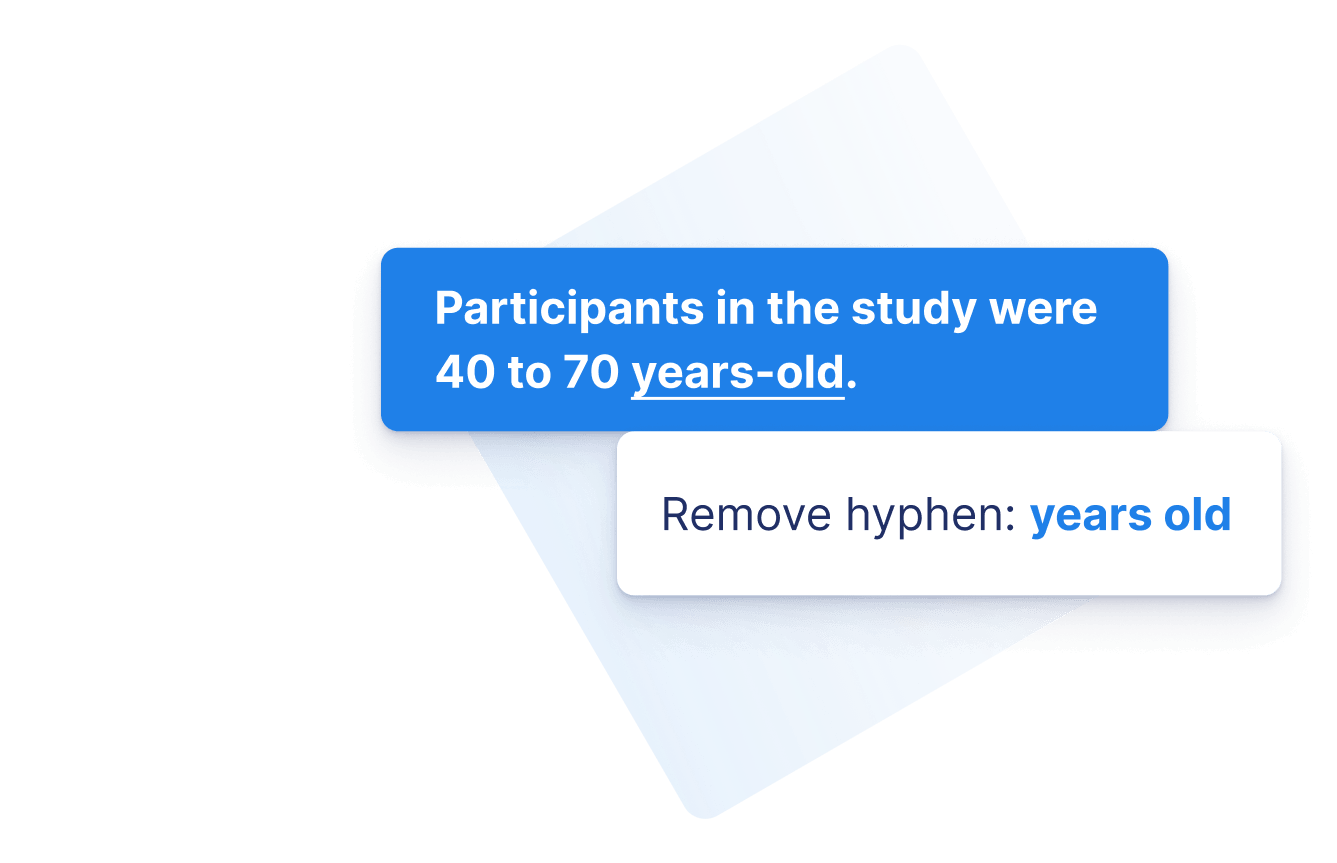
Check your punctuation
Our Grammar Checker takes away all your punctuation worries. Avoid common mistakes with:
- Dashes and hyphens
- Apostrophes
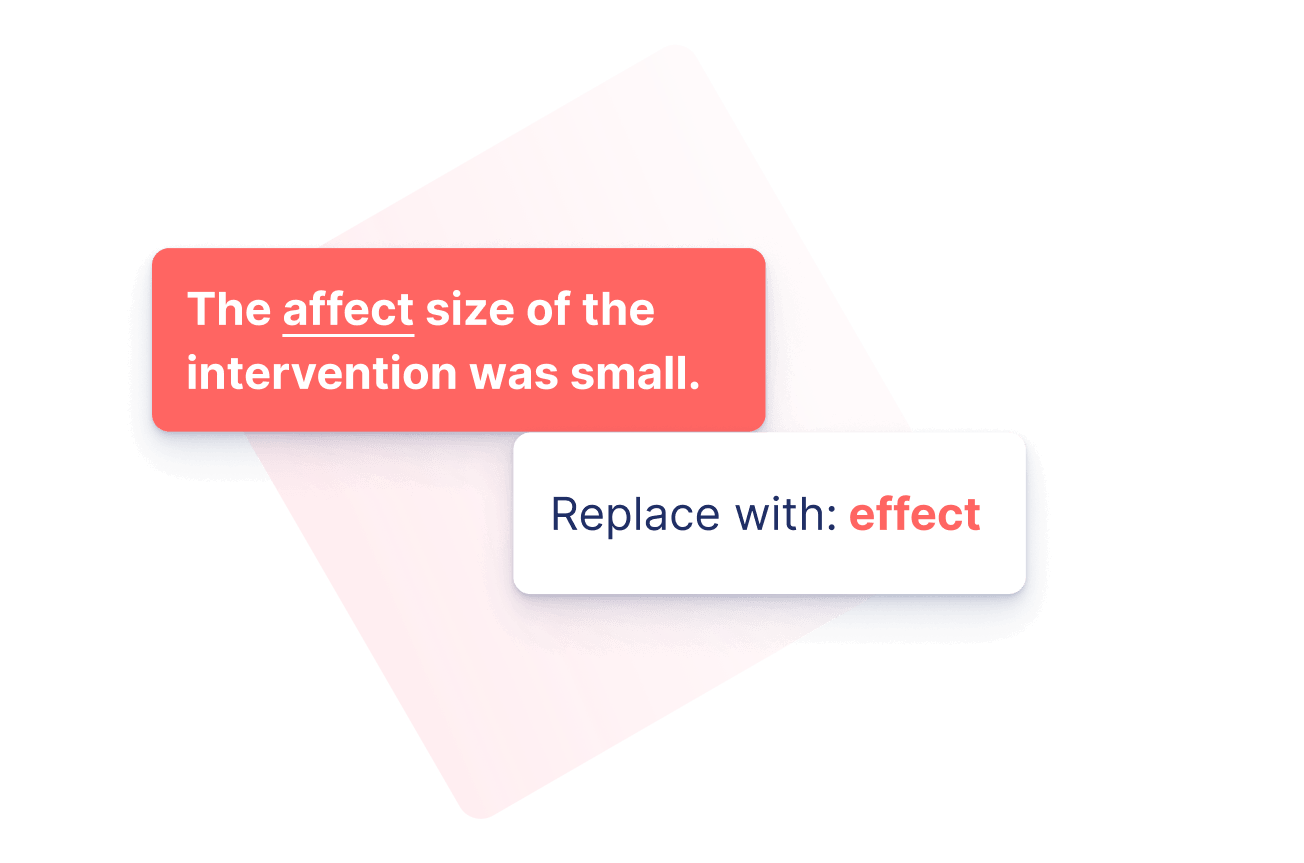
Avoid word choice errors
Should you use “affect” or “effect” ? Is it “then” or “than” ? Did you mean “there,” “their,” or “they’re” ?
Never worry about embarrassing word choice errors again. Our grammar checker will spot and correct any errors with commonly confused words .
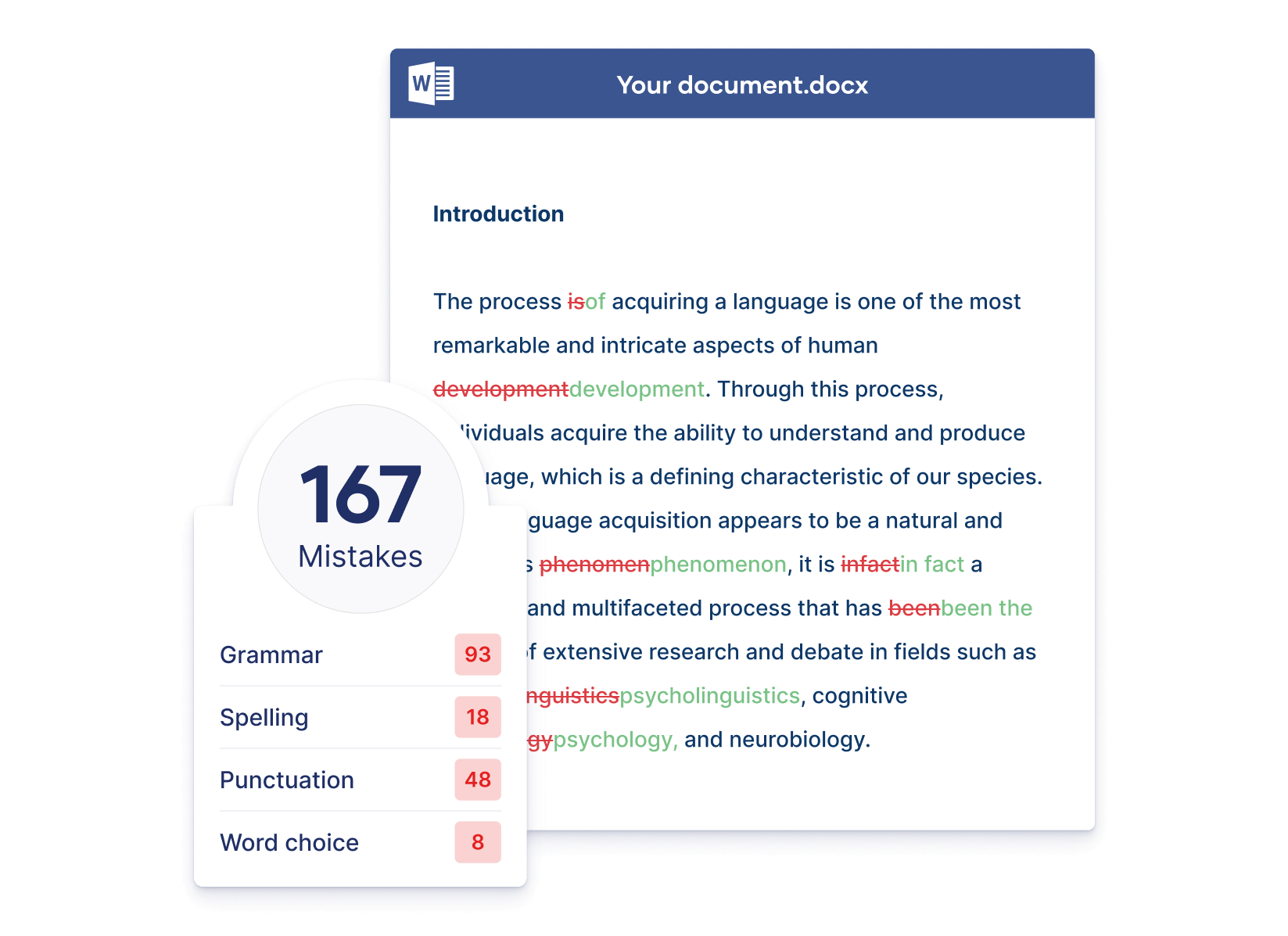
Correct your entire document in 5 minutes
Would you like to upload your entire document and check all your documents for 100+ language issues? Then Scribbr’s AI-powered proofreading is perfect for you.
With AI-powered proofreading, you can correct your text and get a free citation check:
- Upload document
- Wait briefly while all errors are corrected directly in your document
- Correct errors with one click
Proofread my document
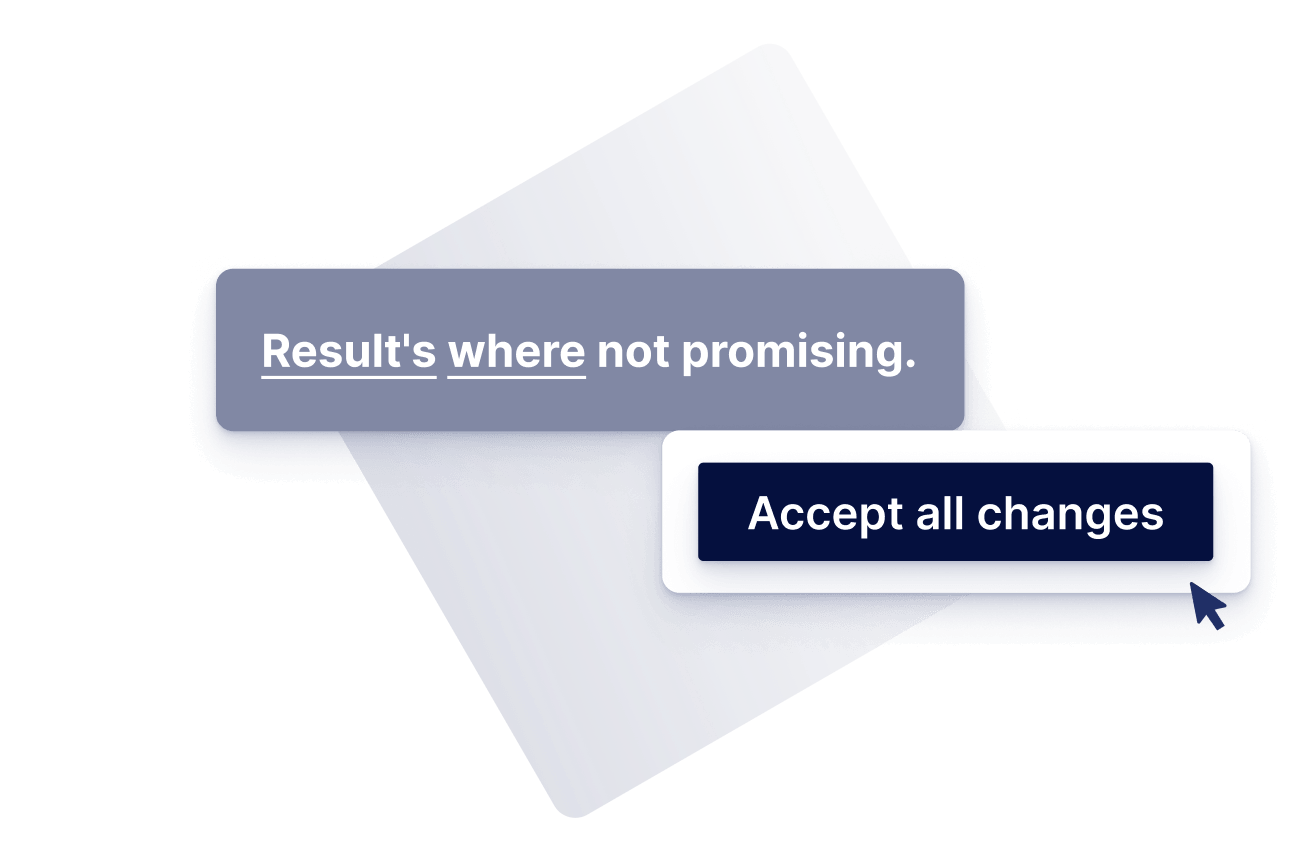
Improve your text with one click
The Scribbr Grammar Checker allows you to accept all suggestions in your document with a single click.
Give it a try!

A Grammar Checker for all English variants
There are important differences between the versions of English used in different parts of the world, including UK and US English . Our grammar checker supports a variety of major English dialects:
- Canadian English
- Australian English
Why users love our Grammar Checker
| 🌐 English | US, UK, CA, & AU |
|---|---|
| 🏆 Quality | Outperforms competition |
| ✍️ Improves | Grammar, spelling, & punctuation |
| ⭐️ Rating | based on 13,370 reviews |
Save time and upload your entire document to fix it in minutes
Scribbr & academic integrity.
Scribbr is committed to protecting academic integrity. Our plagiarism checker , AI Detector , Citation Generator , proofreading services , paraphrasing tool , grammar checker, summarizer , and free Knowledge Base content are designed to help students produce quality academic papers.
We make every effort to prevent our software from being used for fraudulent or manipulative purposes.
Ask our team
Want to contact us directly? No problem. We are always here for you.
- Email [email protected]
- Start live chat
- Call +1 (510) 822-8066
- WhatsApp +31 20 261 6040

Frequently asked questions
The Scribbr Grammar Checker is a tailor-made AI-powered tool that can correct basic language, grammar, style, and spelling errors. We run it so that our editors are free to focus on what they do best: making sure that your paper is free of more nuanced mistakes and providing you with helpful feedback and writing tips.
The Scribbr Grammar Checker is a pro at correcting basic mistakes – and a human editor will still be carefully reviewing your full text – so you can rest assured that your paper is in very good hands!
When you receive back a document that has been reviewed by the Scribbr Grammar Checker, you’ll see two sets of tracked changes in it: one set from the grammar checker and one set from your editor. That way, you can easily tell who made what changes in your paper.
Not sure how tracked changes work in Word or how to review your edited file? Read our handy guide to learn more.
We tested ten of the most popular free grammar checkers to see how many errors they could fix in our sample text and deducted points for any new errors introduced. We also evaluated the tools’ usability.
When compared all the other grammar checkers we tested for this comparison and Scribbr performed exceptionally well. It was successful in detecting and correcting 19 of the 20 errors. See the full review here .
If our grammar checker flags an error that is not actually an error, you have several options:
1. Ignore the error: Most grammar checkers allow users to skip or ignore suggestions they do not agree with or find irrelevant. If you are confident that the flagged “error” is not an issue, you can bypass the suggestion and move on to the next one.
2. Review the context: Take a moment to thoroughly review the context surrounding the flagged error. Sometimes, the initial correct usage might still create confusion or ambiguity within the specific context, and reconsidering the phrasing could improve overall clarity.
Yes, this grammar checker covers the following mistakes:
1. Grammar: Correction of grammatical errors such as subject-verb agreement, tense usage, and sentence structure
2. Spelling: identification and correction of spelling errors, including typos and commonly confused words.
3. Punctuation: Detection and rectification of punctuation errors, including incorrect use of commas, periods, colons, and other punctuation.
4. Word choice errors: Catch words that sound similar but aren’t, like their vs. they’re and your vs. you’re.
Yes. There’s no sign up or payment required to use the grammar checker.
Yes. The grammar checker fixes any text, no matter what the medium is.
The Scribbr grammar checker finds more errors than many other tools and is particularly user-friendly:
- Winner: In our test comparison, the Scribbr grammar checker found 19 out of 20 errors, putting it in first place.
- No registration required: You don’t need an account to use the grammar checker.
- No limits: There is no character or word limit.
- Ad-free: There is no advertising on Scribbr to distract from the tool.
For more details, feel free to read our test of the best English grammar checkers.

Reading & Math for K-5
- Kindergarten
- Learning numbers
- Comparing numbers
- Place Value
- Roman numerals
- Subtraction
- Multiplication
- Order of operations
- Drills & practice
- Measurement
- Factoring & prime factors
- Proportions
- Shape & geometry
- Data & graphing
- Word problems
- Children's stories
- Leveled Stories
- Sentences & passages
- Context clues
- Cause & effect
- Compare & contrast
- Fact vs. fiction
- Fact vs. opinion
- Main idea & details
- Story elements
- Conclusions & inferences
- Sounds & phonics
- Words & vocabulary
- Reading comprehension
- Early writing
- Numbers & counting
- Simple math
- Social skills
- Other activities
- Dolch sight words
- Fry sight words
- Multiple meaning words
- Prefixes & suffixes
- Vocabulary cards
- Other parts of speech
Punctuation
Capitalization
- Narrative writing
- Opinion writing
- Informative writing
- Cursive alphabet
- Cursive letters
- Cursive letter joins
- Cursive words
- Cursive sentences
- Cursive passages
- Grammar & Writing
Breadcrumbs
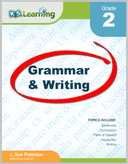
Download & Print Only $6.49
Grade 2 Grammar & Writing Worksheets
Second grade language arts.
These worksheets introduce students to the parts of speech, punctuation and related concepts which form the building blocks for writing proper sentences and paragraphs.
Other parts of speech
Writing paragraphs
Writing prompts

Grade 2 Grammar & Writing Worksheet
What is K5?
K5 Learning offers free worksheets , flashcards and inexpensive workbooks for kids in kindergarten to grade 5. Become a member to access additional content and skip ads.

Our members helped us give away millions of worksheets last year.
We provide free educational materials to parents and teachers in over 100 countries. If you can, please consider purchasing a membership ($24/year) to support our efforts.
Members skip ads and access exclusive features.
Learn about member benefits
This content is available to members only.
Join K5 to save time, skip ads and access more content. Learn More
- Forgot Password?
Pardon Our Interruption
As you were browsing something about your browser made us think you were a bot. There are a few reasons this might happen:
- You've disabled JavaScript in your web browser.
- You're a power user moving through this website with super-human speed.
- You've disabled cookies in your web browser.
- A third-party browser plugin, such as Ghostery or NoScript, is preventing JavaScript from running. Additional information is available in this support article .
To regain access, please make sure that cookies and JavaScript are enabled before reloading the page.

Comparative Study of Writing Assignments across Different Disciplines
- July 13, 2024

Writing assignments at college after high school homework can be intimidating in their variety. In fact, it is enough to understand the requirements for the format and what the teacher wants to test with it, and then it will become easier to meet the criteria and get a high grade.
To simplify the task, we have collected the main types of student assignments and recommendations for writing them.
The essay emphasizes the author’s judgments. The student’s main task is to present and justify a thesis. You can use the Essay Generator tool if you don’t know how to do it right. It will create a paper that will give you a clear understanding of what to write in your essay.
A broad topic for an essay might be the philosophy of Michel Foucault . However, the paper still needs to focus on a specific aspect that can be explored using theory, academic sources, and one’s judgment. For example, you should prove that there is no positive project in Foucault’s theory or show how the concept of biopower is reflected in the context of the COVID-19 pandemic .
Assignment structure . To build the essay’s logic better, you can use a ready-made structure – for example, “five paragraphs.”
State the problem in the introduction. Then, in the main part, there follows an argument based on sources: in the case of Foucault, these can be excerpts from the works of the philosopher himself, texts of his followers, statistical and journalistic data – everything that supports the thesis. The main conclusions are stated in the final part, and then a list of references is given.
In an essay, you can allow yourself a freer style of narration than, for example, in a report or coursework. In some cases, using figurative language or emotional pathos is appropriate, but you should not get carried away with this – an academic essay should still follow some rules.
Analytical note or report
An analytical note is a type of student work stylized as a real working document. Such an assignment can be given at a project seminar or a course on management practices. The student’s task is to briefly describe the state of affairs in a specific situation and, possibly, propose solutions to pressing problems.
It is important to maintain style and form in an analytical note. For example, the addressee and date of compilation must be indicated on the first page, and first-person narration is not used in the document’s text. In addition, the teacher tests analytical abilities, so pay special attention to describing possible solutions to a crisis situation.
Assignment structure . In general, an analytical note begins with a descriptive part—a statement of the problem. Then, there is a review of the situation and an analysis of the causes of the problem. Ideally, these are supported by real data, such as statistics. Finally, they describe possible solutions and actions to prevent similar events from happening again in the future.
For example, if the note’s purpose is to analyze the USA’s youth policy, then the work will include considering the pros and cons of American youth policy, identifying the main problems, and making several recommendations for solving them.
A similar type of student work is an analytical report. Its larger size and emphasis on describing the situation without attempting to provide expert advice distinguish it. If it were necessary to write a report on the youth policy of the USA, the student would study the program documents in more depth, describe the dynamics of youth policy reforms in the USA and ongoing projects, and at the end, give a personal assessment of the state of affairs.
Research paper
A research paper covers the literature on a given topic, a more rigorous task than an essay. It also means analyzing one material: a book, an article, or something else. In both cases, the student’s main task is to arrange the text and group information logically, highlight the main point, and, if necessary, draw conclusions about the problem being described.
Assignment structure . In the introduction to the research paper, it is recommended that you describe the topic’s relevance and justify your scientific interest in it or its practical significance. Sometimes, you may also need to highlight the problem to narrow the topic and focus on specific issues.

Newburgh Brewing Company thrives under Halayko’s leadership

Driver killed in shopping center parking lot crash was 16; had learner’s permit

Wanted man indicted for attempted murder of cop

Kingston mayor anticipates approval to remove Pike Plan canopy

Flood watch issued for region

Serving New York’s Hudson Valley and Catskill for over 23 Years
We’re the news source where other reporters get their news
Newsroom: [email protected] [email protected]
Advertising: [email protected]
Publisher: [email protected]
924 Homestead Avenue Maybrook, NY 12543
One Civic Center Plaza Poughkeepsie, NY 12601
Copyright 2023 © NY Newswire LLC | All rights reserved. Site built by Systemagic
Purdue Online Writing Lab Purdue OWL® College of Liberal Arts
Understanding Writing Assignments

Welcome to the Purdue OWL
This page is brought to you by the OWL at Purdue University. When printing this page, you must include the entire legal notice.
Copyright ©1995-2018 by The Writing Lab & The OWL at Purdue and Purdue University. All rights reserved. This material may not be published, reproduced, broadcast, rewritten, or redistributed without permission. Use of this site constitutes acceptance of our terms and conditions of fair use.
How to Decipher the Paper Assignment
Many instructors write their assignment prompts differently. By following a few steps, you can better understand the requirements for the assignment. The best way, as always, is to ask the instructor about anything confusing.
- Read the prompt the entire way through once. This gives you an overall view of what is going on.
- Underline or circle the portions that you absolutely must know. This information may include due date, research (source) requirements, page length, and format (MLA, APA, CMS).
- Underline or circle important phrases. You should know your instructor at least a little by now - what phrases do they use in class? Does he repeatedly say a specific word? If these are in the prompt, you know the instructor wants you to use them in the assignment.
- Think about how you will address the prompt. The prompt contains clues on how to write the assignment. Your instructor will often describe the ideas they want discussed either in questions, in bullet points, or in the text of the prompt. Think about each of these sentences and number them so that you can write a paragraph or section of your essay on that portion if necessary.
- Rank ideas in descending order, from most important to least important. Instructors may include more questions or talking points than you can cover in your assignment, so rank them in the order you think is more important. One area of the prompt may be more interesting to you than another.
- Ask your instructor questions if you have any.
After you are finished with these steps, ask yourself the following:
- What is the purpose of this assignment? Is my purpose to provide information without forming an argument, to construct an argument based on research, or analyze a poem and discuss its imagery?
- Who is my audience? Is my instructor my only audience? Who else might read this? Will it be posted online? What are my readers' needs and expectations?
- What resources do I need to begin work? Do I need to conduct literature (hermeneutic or historical) research, or do I need to review important literature on the topic and then conduct empirical research, such as a survey or an observation? How many sources are required?
- Who - beyond my instructor - can I contact to help me if I have questions? Do you have a writing lab or student service center that offers tutorials in writing?
(Notes on prompts made in blue )
Poster or Song Analysis: Poster or Song? Poster!
Goals : To systematically consider the rhetorical choices made in either a poster or a song. She says that all the time.
Things to Consider: ah- talking points
- how the poster addresses its audience and is affected by context I'll do this first - 1.
- general layout, use of color, contours of light and shade, etc.
- use of contrast, alignment, repetition, and proximity C.A.R.P. They say that, too. I'll do this third - 3.
- the point of view the viewer is invited to take, poses of figures in the poster, etc. any text that may be present
- possible cultural ramifications or social issues that have bearing I'll cover this second - 2.
- ethical implications
- how the poster affects us emotionally, or what mood it evokes
- the poster's implicit argument and its effectiveness said that was important in class, so I'll discuss this last - 4.
- how the song addresses its audience
- lyrics: how they rhyme, repeat, what they say
- use of music, tempo, different instruments
- possible cultural ramifications or social issues that have bearing
- emotional effects
- the implicit argument and its effectiveness
These thinking points are not a step-by-step guideline on how to write your paper; instead, they are various means through which you can approach the subject. I do expect to see at least a few of them addressed, and there are other aspects that may be pertinent to your choice that have not been included in these lists. You will want to find a central idea and base your argument around that. Additionally, you must include a copy of the poster or song that you are working with. Really important!
I will be your audience. This is a formal paper, and you should use academic conventions throughout.
Length: 4 pages Format: Typed, double-spaced, 10-12 point Times New Roman, 1 inch margins I need to remember the format stuff. I messed this up last time =(
Academic Argument Essay
5-7 pages, Times New Roman 12 pt. font, 1 inch margins.
Minimum of five cited sources: 3 must be from academic journals or books
- Design Plan due: Thurs. 10/19
- Rough Draft due: Monday 10/30
- Final Draft due: Thurs. 11/9
Remember this! I missed the deadline last time
The design plan is simply a statement of purpose, as described on pages 40-41 of the book, and an outline. The outline may be formal, as we discussed in class, or a printout of an Open Mind project. It must be a minimum of 1 page typed information, plus 1 page outline.
This project is an expansion of your opinion editorial. While you should avoid repeating any of your exact phrases from Project 2, you may reuse some of the same ideas. Your topic should be similar. You must use research to support your position, and you must also demonstrate a fairly thorough knowledge of any opposing position(s). 2 things to do - my position and the opposite.
Your essay should begin with an introduction that encapsulates your topic and indicates 1 the general trajectory of your argument. You need to have a discernable thesis that appears early in your paper. Your conclusion should restate the thesis in different words, 2 and then draw some additional meaningful analysis out of the developments of your argument. Think of this as a "so what" factor. What are some implications for the future, relating to your topic? What does all this (what you have argued) mean for society, or for the section of it to which your argument pertains? A good conclusion moves outside the topic in the paper and deals with a larger issue.
You should spend at least one paragraph acknowledging and describing the opposing position in a manner that is respectful and honestly representative of the opposition’s 3 views. The counterargument does not need to occur in a certain area, but generally begins or ends your argument. Asserting and attempting to prove each aspect of your argument’s structure should comprise the majority of your paper. Ask yourself what your argument assumes and what must be proven in order to validate your claims. Then go step-by-step, paragraph-by-paragraph, addressing each facet of your position. Most important part!
Finally, pay attention to readability . Just because this is a research paper does not mean that it has to be boring. Use examples and allow your opinion to show through word choice and tone. Proofread before you turn in the paper. Your audience is generally the academic community and specifically me, as a representative of that community. Ok, They want this to be easy to read, to contain examples I find, and they want it to be grammatically correct. I can visit the tutoring center if I get stuck, or I can email the OWL Email Tutors short questions if I have any more problems.

Why I ban AI use for writing assignments
Students may see handwriting essays in class as a needlessly time-consuming approach to assignments, but I want them to learn how to engage with arguments, develop their own views and convey them effectively, writes James Stacey Taylor
James Stacey Taylor
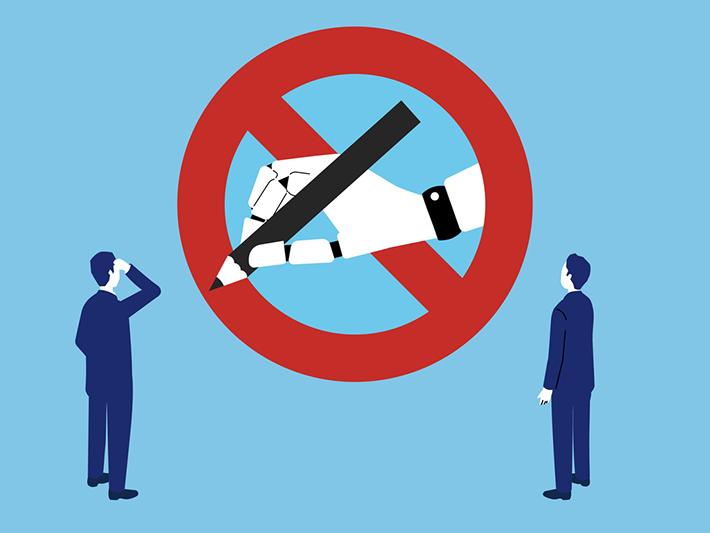
You may also like

Popular resources
.css-1txxx8u{overflow:hidden;max-height:81px;text-indent:0px;} Why I ban AI use for writing assignments
What does it mean for students to be ai-ready, an introvert’s guide to networking, teach the skills required for a future we can’t yet imagine, emotions and learning: what role do emotions play in how and why students learn.
I used to allow students to use artificial intelligence to help them write their papers. I spent a lot of class time explaining how AI works, how they can use it to help them write if they wish, and how I expect them to document its use if they draw on it. I did this because students are likely going to have to know how to use it, and so we should help them understand how to do so effectively and ethically.
But I now think that allowing AI use for student writing assignments is a mistake – at least in lower-level classes. It doesn’t help students learn what I want them to learn through writing papers for class. So, I have banned its use.
The ban is simple: students are not allowed to use AI in writing their papers. They cannot use it to generate ideas, to “improve” their writing or (obviously) to write their papers for them.
- Advice for writing and teaching writing
- Common features of LLM-created writing
- Resource collection: AI and assessment in higher education
Eliminating AI use is also simple in practice. Students do much of the initial work on their papers in class. They read, in class, short academic works. They identify the conclusions being argued for and the reasons given for them. They then draft by hand (without access to electronic devices) an exegesis of the author’s position. We reconvene to discuss the view, and in another class period students write their initial take on things. They complete the paper outside class, handing in their initial handwritten work to accompany their typed papers.
The in-class work is not presented to the students as a way to ensure that they’re not using AI. That would undermine the trust needed between students and instructors for a class to be effective. Rather, this work is done in class, without electronics, to ensure students can work in a distraction-free environment suited for careful and sustained thought.
Why handwriting rather than typing? This slows things down and encourages thought.
Teaching text understanding without AI
Just as the ban is simple, so is the reason for it: I want students to learn how to engage with arguments.
To do this, they need to read and understand the author’s conclusion. They need to understand the author’s arguments for that view. They need to think about whether the premises of those arguments support the conclusion – and, if they do not, whether they could be modified to do so or whether the argument needs to be abandoned. If the premises do support the conclusion, they need to think about whether they’d also support a counterintuitive conclusion – and, if so, whether this shows that some of the premises should be rejected.
Could students use AI to do some of this? Sure. They could, for example, ask AI to outline the philosopher Peter Singer’s argument for famine relief. AI does a nice job of this. But if students use AI in this way, they won’t develop the skill of working out what the author is arguing for and how they do that. I don’t want students to be able to read a digested summary of a paper. I want them to develop the skill to produce such a summary themselves, identifying the main points of an argument and working out how they support the conclusion.
Could they use AI to generate objections to the arguments they read? Of course. AI does a good job of summarising objections to Singer’s view. But I don’t want students to parrot others’ objections. I want them to think of objections themselves.
Could AI be useful for them in organising their exegesis of others’ views and their criticisms of them? Yes. But, again, part of what I want my students to learn is precisely what this outsources to the AI: how to organise their thoughts and communicate them effectively.
Having students start their essays in class and by hand helps them develop their views and how to convey them effectively. As they work through the process of writing their papers, they often realise that their thoughts aren’t as well developed as they thought. I want them to master these skills.
When students resist an AI-free writing process
Some students are initially resistant to what they see as a needlessly time-consuming approach to writing . Used to skimming texts and banging out a fast 1,000 words, they dislike having to slow down. And when they slow down, some discover that they are less able to engage with texts than they believed.
This identifies weaknesses that students did not know they had. But it has also led to some students becoming frustrated at what they see as pedantry on my part. Isn’t their exegesis “good enough” if it “captures the gist” of what was written? More challenging is that if students can succeed without engaging with the texts they read, what questions does this raise about the value of such engagement? This, by implication, casts doubt on the value of a liberal arts education itself. If students can succeed in their chosen careers without being able to critically engage with texts, it is difficult to justify the claim that it is important that they develop that skill. The prevalence of AI is raising questions not just about its appropriate use in the classroom but about whether some of those classrooms are important at all.
Other students, however, have expressed appreciation for this slower, more careful analogue approach. One told me that my classes were the only times in his college career he’d felt “like a scholar”; a senior told me she was proud of having finally grappled with a problem and written something that was entirely hers. Several have told me this approach got them to think about ideas rather than grades.
So, goodbye, AI.
James Stacey Taylor is a professor of philosophy in the department of philosophy, religion and classical studies in the School of Humanities and Social Sciences at The College of New Jersey.
If you would like advice and insight from academics and university staff delivered direct to your inbox each week, sign up for the Campus newsletter .
Uoffer Global empowers international students through innovative pathway programmes
Partnering with industry for authentic experiences, a diy guide to starting your own journal, use gamification to teach international relations concepts, five questions to ask when embedding cultural competency.
Register for free
and unlock a host of features on the THE site
The Definitive Voice of Entertainment News
Subscribe for full access to The Hollywood Reporter
site categories
How ‘fly me to the moon’ writer rose gilroy stopped at nothing to write for scarlett johansson.
Though she "was really green" and without a WGA card, the scribe won the job for the space comedy-drama by writing the first 15 pages on spec.
By Brian Davids
Brian Davids
- Share on Facebook
- Share to Flipboard
- Send an Email
- Show additional share options
- Share on LinkedIn
- Share on Pinterest
- Share on Reddit
- Share on Tumblr
- Share on Whats App
- Print the Article
- Post a Comment

It’s easy to assume that a screenwriter with the last name Gilroy had an effortless foray into show business, but that was anything but the case for Fly Me to the Moon ’s Rose Gilroy .
Related Stories
Scarlett johansson wants honest reviews of her clean beauty line on amazon -- here are the outset's best products on sale for prime day, box office: 'despicable me 4' easily wins with $44.7m as 'longlegs' stuns with record $22.6m launch.
So she started writing scripts, including a psychological thriller called The Pack , which is currently in development and has Alexander Skarsgård attached as director and star. (It’s unclear if Florence Pugh remains involved.) This sample, as well as a sci-fi script, eventually opened the door to a meeting with Scarlett Johansson ’s production company, These Pictures, which is led by the actor and her producing partners, Keenan Flynn and Jonathan Lia. That’s when they pitched Gilroy on the general idea for Fly Me to the Moon , then known as Project Artemis , which revolved around a plot to televise manufactured footage of the 1969 Moon landing with the real audio from the actual Apollo 11 mission.
Gilroy was immediately taken by the NASA-set comedy/drama, but despite her interest and persistence, her lack of professional work and no WGA membership became barriers. So, as a last-ditch effort, she took the initiative and bet on herself.
“Ultimately, I was really green and not in the guild, so [These Pictures] were like, ‘We like your stuff, but this is such a gamble,’” Gilroy tells The Hollywood Reporter . “So I wrote the first 15 pages on spec with their pitch, and I won the job that way. We then spent years developing it internally just with Scarlett’s company before she even took it out.”
“It was beyond my wildest dreams. I was totally shocked and in awe. The idea that Scarlett would be delivering lines from something I wrote — I’m still pinching myself,” Gilroy says. “I am convinced this is a really elaborate prank on me, so it was crazy.”
The film then became a reunion between Johansson and longtime friend/collaborator, Chris Evans, but the revolving door of Hollywood had its way, resulting in Channing Tatum joining as the male lead, NASA director Cole Davis. Greg Berlanti also replaced Jason Bateman in the director’s chair, and now, at long last, the outcome is a well-received romcom drama with the escapades of Ocean’s Eleven and Catch Me If You Can . And, at a time when our present-day real world is brimming with conspiracies and cynicism, Gilroy is proud to be a part of a patriotic film that celebrates one of America’s greatest accomplishments.
That said, for a film that pokes fun at the Moon landing conspiracy, there, of course, had to be references to filmmaker Stanley Kubrick, whom conspiracy theorists still credit with staging the Moon landing. So the film features a couple lines in reference to The Shining filmmaker, but Gilroy is now revealing that there were early drafts of the script where Jim Rash’s fictional director character was originally Kubrick himself.
“There was an early draft where Stanley Kubrick was in it, but it was kind of kooky and didn’t feel right,” Gilroy shares.
So I’d like to get the Rose Gilroy story first. Did you resist the family business for a period of time, or did it always feel like a foregone conclusion?
I resisted the family business for a really long time, and I took a traditionally academic path. I went to a small liberal arts school, pre-med, and I legitimately wasn’t smart enough. I tried so hard in all the classes and I just couldn’t get through them. I would work harder than everyone else and still get a C. So then I was pre-law, unofficially, and studying for the LSAT, and everything just got derailed when I graduated. So I really just started writing out of futility. I didn’t know what else to do, and it was the first thing that people said I was good at.
I should also say that I worked as a research assistant for all four years of college, and I would not be where I am today had I not done that. So much of my inspiration and writing process comes from research and just being able to dig deep on a topic or a specific world. In the case of Fly Me to the Moon , it was NASA in the 1960s and the Apollo era. So [college] ended up being good for something else, and that’s the long and the short of it.
I never thought about it that way. I really didn’t. I did model for a brief time, and I loved the people that I met and the friends that I made. So I have nothing against the industry, but I was just really lost during that time. It can be hard; it’s short money. So I am grateful that I found this and am able to have something else. All my friends would get promotions, and I would work a couple times a month on some editorial shoot, so I was grateful to transition out of it. But I never thought about it as unique. I don’t know why.
In 2018 or 2019, you started with shorts and some TV, and then, in 2021, Scarlett Johansson’s company, These Pictures, generated the idea for this film and developed the story. How did the writing assignment ultimately end up in your hands?
So I started harassing them for the job. ( Laughs .) But, ultimately, I was really green and not in the guild, so they were like, “We like your stuff, but this is such a gamble.” So I wrote the first 15 pages on spec with their pitch, and I won the job that way. We then spent years developing it internally just with Scarlett’s company before she even took it out. So I got so lucky to get to work with her and develop it with her, and like the moon landing itself, this script was developed in the spirit of collaboration. So that’s how it happened.
You have people in your inner circle who can deliver a line for you out loud. They can also offer notes on a draft. Did you make those requests throughout the writing process?
Of course, I got notes — not just from my family, but from everyone. And, growing up in my family, I knew from my dad [Dan Gilroy] that this is not a glamorous job. It is hours in front of a computer screen, alone, and writing is rewriting. So I took notes from everyone. You have to get as many notes as you can. Also, the greatest thing that my parents and other people gave me was not BS-ing me. They just gave me the hard truth: “This is not good,” or, “This needs work.” So that’s how you get better. That’s the only way you can get better, aside from reading other scripts online. So I definitely got notes from people.
Well, it was beyond my wildest dreams. I was totally shocked and in awe. The idea that Scarlett would be delivering lines from something I wrote — I’m still pinching myself. I am convinced this is a really elaborate prank on me, so it was crazy. But I will say to her and Keenan’s credit, I handed in a draft and they gave me a lot of notes. There were a lot of notes after I handed in that first draft. And then, from there, I took those notes and I worked really hard to put them in. I then sent the script back, and then it was like, “Hey, this is feeling good.” So there were more notes from there, but she added so much to this character. Scarlett exists on every page of the script. So I was just blown away to get to work with her in that capacity, and the fact that she was going to play Kelly just blew my mind.
The comps for Kelly, at least to me, are Don Draper meets Saul Goodman/Jimmy McGil and Kim Wexler. (Kelly — like Kim on Better Call Saul — pulls off a grift using a fake pregnant belly.) Did you break her down that specifically?
There was a time when conspiracy theories were mostly enjoyed as entertainment. But that’s no longer the case as there’s a new one every five minutes, and they’re anything but fun now. So I was quite relieved at how you cleverly dealt with one of the oldest conspiracies involving the Moon landing. Did you have a lot of apprehension about how to walk that tightrope, especially with NASA’s involvement hanging in the balance?
I became interested in this project initially because I have a huge admiration and interest in NASA and the Apollo era and what they did and the significance of it. The human accomplishment of getting ourselves off this planet and onto another world really meant something to me. So I was never worried about the conspiracy element because my intention on every page was to try and honor and celebrate what NASA did on that day. You can still have fun with things, though. You can call things out and have some fun, and still make a film that is ultimately about the fact that the truth matters. I actually was not aware of how massive and far-reaching the conspiracy is, because, when I look at everything online, it’s so clear to me that it did happen. So it was always my intention, and the intention of everyone around me, to celebrate the Moon landing, and the conspiracy was never really in the forefront of my mind.
Absolutely, just as a lot of conspiracies do. There was just never a doubt in my mind. A lot of times, when you ask somebody why they don’t think that we went, they’ll say, “Well, we never went back.” We actually went back six times, and it would’ve been seven had the EECOM system on Apollo 13 not failed. So it all plays into the part of the movie that people only really cared about this because it was a race with the Russians, and if there’s no funding and money, then the public doesn’t know about it. So we addressed it in an interesting, roundabout way that also honors what happened, and it was such a cool thing that America did. So this film feels patriotic to me. It celebrates what we did.
If you had to, do you think you could make a strong case to a denier now?
Yeah, there are some things that are worth correcting, and if I was asked about it or spoken to about it, I’d try my best to again do what this movie does and celebrate what NASA did. I’m so honored to be in a country that’s part of that accomplishment, and it’s a bummer when people try in any way to diminish that. I’d also say, “Go see the movie,” because it’s okay to have fun with it and not take it too seriously.
You knew at some point you’d have to reference Stanley Kubrick, who is credited with directing the conspiracy theorists’ version of the Moon landing in a Hollywood basement. So how many permutations were there as far as Kubrick references?
So Jim Rash’s frustrated filmmaker character likely evolved out of Stanley Kubrick?
Yeah, but I was talking years and years back. And thank God it did [evolve], because, oh my gosh, Jim Rash just blew my mind. And not to throw myself under the bus, but so much of his character was great improv. These lines just came out of the deepest part of him, and I was so grateful to work with him on this.
Fly Me to the Moon was once known as Project Artemis . Did you champion one title in particular?
I love the title we went with. It’s romantic and beautiful and optimistic, and it really hits every quadrant for me. What they landed with just feels right, like it was always supposed to be that.
My colleague wrote a piece on the recent rise of cats on screen , and now your movie is another example of this phenomenon. When you were writing the feline character of Mischief, did you have any sense that a cat wave was coming by way of The Marvels , A Quiet Place: Day One , Argylle and Ripley ?
Fly Me to the Moon is partially about faking it till you make it. The characters were doing that, as was NASA to some degree. Have you also recognized by now that most people are making it up as they go along?
Yeah, definitely. I’m totally making it up as we go along. But Kelly is such a survivor, so you have to be. You also have to bend towards people, and sometimes, you need a little bit of both. Kelly has some amazing points, and Cole has some amazing points, but they have to bend towards each other. So that’s true in real life in a lot of ways.
As you mentioned earlier, The Pack is still making its way through development?
Yeah, it totally is. Strike timing threw everything a little down, but I’m so excited. Alex [Skarsgård] is going to do an incredible job with it, and I have utter faith in him. So I’m very excited for that one as well.
*** Fly Me to the Moon opens in theaters on July 12 .
THR Newsletters
Sign up for THR news straight to your inbox every day
More from The Hollywood Reporter
Glen powell says his parents have made cameos in all his movies — including ‘twisters’, ‘deadpool & wolverine’ soundtrack to feature k-pop group stray kids, channing tatum on going to dark places to play a “psychopath” in ‘blink twice’, ‘superman’ is “close” to being done filming, james gunn says, first look at julia garner in ‘rosemary’s baby’ prequel ‘apartment 7a’, nicole kidman reveals stanley kubrick’s rules for actors during ‘eyes wide shut’ on 25th anniversary.

IMAGES
COMMENTS
Free English Grammar Worksheets: Downloadable and free practice exercises in PDF to improve your English Grammar. Learn about relative clauses, adverbial clauses, if clauses and other key grammar points.
Grammar Checker. Hint → Bookmark GrammarCheck for future use. Latest Exercises. C1 Level Gap Filling Grammar Exercise July 7, 2024; Regular and Irregular Verbs July 6, 2024; Passives July 5, 2024; Afraid To vs. Afraid Of July 4, 2024; Nouns With And Without The July 2, 2024;
Writing skills for K-5. Use these free, printable grammar and writing worksheets to study basic grammar including parts of speech (nouns, verbs, ....), capitalization, punctuation and the proper writing of sentences, paragraphs and longer texts. Included are exercises and writing prompts for narrative, opinion and informational writing. Grammar & writing by grade:
This page has advanced-level grammar worksheets for direct objects and transitive verbs. Use these worksheets to help teach students about avoiding double negatives in writing. Homographs are words that are spelled the same way, but have different meanings. Sometimes they have different pronunciations too.
Other Things. As and Like Exercise 1. Linking words. Linking Words of Contrast (However / Despite / Although) Linking Words of Reason (Because / Since / As / Due to / Owing to) Lots of English grammar exercises and quizzes both online and in PDF to help you practise your English.
With challenges for students of all levels from preschool to fifth grade, our grammar worksheets and printables cover everything from basic parts of speech, plurals, and simple sentences, to punctuation, subject-verb agreement, compound and complex sentences, and much more! Grammar worksheets are an effective way to help kids improve their writing.
Grammar Exercises. These OWL resources contain grammar exercises about adjectives, adverbs, appositives, articles, count and noncount nouns, prepositions, and tense consistency. Please use the navigation bar on the left or the links below to access the individual exercises.
Grammar. These OWL resources will help you use correct grammar in your writing. This area includes resources on grammar topics, such as count and noncount nouns, articles (a versus an), subject-verb agreement, and prepositions. Grammar-related exercises can be found here.
The Quill Lessons tool enables teachers to lead whole-class and small-group writing instruction. Teachers control interactive slides that contain writing prompts, and the entire class responds to each prompt. Each Quill Lessons activity provides a lesson plan, writing prompts, discussion topics, and a follow up independent practice activity.
Find hundreds of grammar worksheets for different topics and levels, from kindergarten to high school. Practice and learn grammar skills such as parts of speech, mechanics, punctuation, sentence structure, and word usage.
A simple sentence contains a subject and a verb, and it may also have an object and modifiers. However, it contains only one independent clause. Key: Yellow, bold = subject; green underline = verb, blue, italics = object, pink, regular font =prepositional phrase. Here are a few examples:
Below you'll find our lists of printable paragraph correction worksheets. On these worksheets, students must choose the best way to correct errors highlighted in the given paragraph. They are tested on their knowledge of punctuation, spelling, syntax, symmetry, vocabulary, and verb tense usage. Each paragraph correction worksheet is 8 questions ...
Common Writing Assignments. These OWL resources will help you understand and complete specific types of writing assignments, such as annotated bibliographies, book reports, and research papers. This section also includes resources on writing academic proposals for conference presentations, journal articles, and books.
Exercises: all levels esl. Improve your English grammar skills with our online exercises. Suitable for beginners, intermediate, and advanced ESL learners.
What this handout is about. The first step in any successful college writing venture is reading the assignment. While this sounds like a simple task, it can be a tough one. This handout will help you unravel your assignment and begin to craft an effective response. Much of the following advice will involve translating typical assignment terms ...
Yes, this grammar checker covers the following mistakes: 1. Grammar: Correction of grammatical errors such as subject-verb agreement, tense usage, and sentence structure 2. Spelling: identification and correction of spelling errors, including typos and commonly confused words. 3. Punctuation: Detection and rectification of punctuation errors, including incorrect use of commas, periods, colons ...
K5 Learning offers free worksheets, flashcards and inexpensive workbooks for kids in kindergarten to grade 5. Become a member to access additional content and skip ads. Exercises and writing prompts covering the parts of speech and the writing of proper sentences and texts.
Free Grammar Checker. Use QuillBot's free online grammar checker tool to perfect your writing by reviewing your text for grammar, spelling, and punctuation errors. Whenever you need to review your writing or grammar check sentences, QuillBot is here to help make the editing process painless. QuillBot's free online sentence corrector helps you ...
K5 Learning offers free worksheets, flashcards and inexpensive workbooks for kids in kindergarten to grade 5. Become a member to access additional content and skip ads. Grammar and writing worksheets for Grade 2 including nouns, verbs, adjectives, adverbs, sentences, punctuation, capitalization, writing paragraphs and writing prompts.
Communications document from Golden Hills Virtual School, 5 pages, Social Studies 20-2 Related Issue 4 Assignment I Examine the 3 sources on the following pages for the writing assignment Examine each source. Write a response in paragraph form and answer the following questions: What do each of the three sources communic
Writing assignments at college after high school homework can be intimidating in their variety. In fact, it is enough to understand the requirements for the format and what the teacher wants to ...
The programming assignment writing services discussed above have a strong professionalism and integrity track record. They are recognized for their commitment to quality and adherence to ethical ...
Many instructors write their assignment prompts differently. By following a few steps, you can better understand the requirements for the assignment. The best way, as always, is to ask the instructor about anything confusing. Read the prompt the entire way through once. This gives you an overall view of what is going on.
Students may see handwriting essays in class as a needlessly time-consuming approach to assignments, but I want them to learn how to engage with arguments, develop their own views and convey them effectively, writes James Stacey Taylor ... But I now think that allowing AI use for student writing assignments is a mistake - at least in lower ...
Similarity Report and AI Writing guidance: Academic integrity tools: Creating PeerMark assignments guidance: Class and assignment management: Creating and managing QuickMarks, rubrics and grading PeerMark assignments guidance: Grading and feedback: User profile guidance for administrators and instructors: User profile settings
How did the writing assignment ultimately end up in your hands? This was the first paid job I ever had. I was not in the guild [WGA] when I got this job, but I'd been writing for three-and-a ...